
Spring 2021 • Number 39
SEAFOOD FORAGING • NEW DAVID KINCH COOKBOOK NUT BUTTERS • RADICCHIO • OLIVE OIL • POT PRIMER
Celebrating the Local Food and Drink of Santa Cruz, Monterey and San Benito Counties Member of Edible Communities
We’re on a mission to prove that sustainably sourced, local cannabis creates thriving communities and a resilient planet.
























Visit SantaCruzNaturals.org for delivery, menus and more!
C10-0000237-LIC | C10-0000238-LIC
www.ediblemontereybay.com 1 Half Moon Bay • Downtown Santa Cruz Westside Santa Cruz • Capitola • Aptos EARN REWARDS WHILE YOU SHOP Sign up at newleaf.com/neighbor and earn points on every purchase. LOCALLY GROWN & ORGANIC Strawberries, artichokes, and asparagus are arriving now! SHOP SAFELY FROM HOME For contactless delivery or curbside pickup, start your order at newleaf.com/instacart. We’re fans of responsibly-raised meats, sustainable seafood, and California wines, and we know you are, too. Shop with us and share our commitment to the beautiful Central Coast. 10% of profits go back to the community

4 GRIST FOR THE MILL 6 EDIBLE NOTABLES Carmel-by-the-Sea Farmers’ Market comes into its own; Calavera Coffee brings the hip factor to Hollister; In a new cookbook, chef David Kinch shares the dishes he loves to serve friends at his home in Santa Cruz 19 WHAT’S IN SEASON RADICCHIO Bitter and beautiful, learn how to use these stunning vegetables 25 FOODSHED Spring FARMERS’ MARKETS A complete guide for the Monterey Bay area 27 EDIBLE PROVISIONS NUT BUTTERS 30 SPRING FORAGING ACCESSING ANOTHER LEVEL Fin + Forage aims to change perceptions of spearfishing and takes our intrepid reporter on a freediving adventure in Big Sur 36 EDIBLE COMMUNITY TASTE OF HOME While the pandemic keeps us physically distant, a boom of cottage bakeries and residential restaurants brings new faces and new cuisines into the local food community 43 IN THE ORCHARD OLIVE OIL SYNERGIES How four California specialty olive oil producers are making the whole more than the sum of the parts 51 EDIBLE ENTERTAINING LAVENDER CHÈVRE CHEESECAKE A festive dessert for any springtime occasion 52 EDIBLE ADVENTURE NORTH STAR Chef John Cox follows his heart to a haunted hotel on a remote island in the Pacific Northwest 59 EDIBLE D.I.Y. POT PRIMER Forget the grow lights and fancy fertilizers, a gardening expert explains how to grow your own in 10 easy steps 64 LAST CALL CRAFT ROOTS Trendy new spot combines vegan food and CBD cocktails RECIPES IN THIS ISSUE 16 Salmon with Soy & Ginger 22 Radicchio Salad with Citrus Vinaigrette 34 Waterman Martini 35 Rockfish-Scallop Ceviche with Crispy Skin and Sea Lettuce Chicarrons 48 Celery Root and Leek Soup with Green Garlic Gremolata 51 Lavender Chèvre Cheesecake COVER PHOTOGRAPH Seafood feast prepared by chef Colin Moody after Fin + Forage freedive in Big Sur by Glen McDowell CONTENTS PHOTOGRAPH Joe Platko Contents
FOR OVER 80 YEARS, SHOPPERS CORNER HAS BEEN PROUDLY SERVING THE SANTA CRUZ COMMUNITY.























































We delight ourselves in bringing you the highest quality meats, produce, wines and specialty items, many of which come from local vendors right in our own back yard. Over the years we have found that by using the best available ingredients, you get the best possible meals! So when looking to prepare that perfect feast, know that we are here and happy to help. From our family to yours....Thank you for making Shoppers Corner a cherished part of the Santa Cruz community











www.ediblemontereybay.com 3 NOWSOLAR POWERED Located on the corner of Branciforte & Soquel in
SHOPPERSCORNER.COM | 831-423-1398 OPEN EVERYDAY 7-8
Santa Cruz
SWELLIES
2020
GRIST FOR THE MILL edible
Last year about this time I wrote about the hope and promise that springtime brings and how it is my favorite season of all. The 12 months since then turned out to be a time that most of us would rather forget. We’ve run the gauntlet of pandemic phases starting with hope and followed by attempts at resilience, perseverance, pivoting, self-reliance, love for the local community and even holiday celebrations by Zoom. What’s next? We at Edible Monterey Bay think it’s time for ADVENTURE! Turn off Netflix, get off the couch, mask up and try something new. We hope our fresh spring issue inspires you to get out of that rut.
Start small by making a new dish for dinner. We have fabulous recipes from chefs David Kinch, Cori Goudge-Ayer and Ben Spungin, as well as the lightest, most luscious spring cheesecake you’ve ever tasted, from our own writer and recipe developer Jessica Tunis.
Give in to temptation and sample an exotic new dish in takeout form, cooked by one of the multitude of home-based pop-ups that Raúl Nava found on Instagram for his story “A Taste of Home,” about the positive flip side of pandemic dining.
Then maybe venture out and discover a new market, like the revitalized and youthful Carmelby-the-Sea Farmers’ Market that Kathryn McKenzie explores in her story “Friendly Posh.” Or try the new Staff of Life natural foods market in Watsonville, set to open March 30 and joining us as a much-appreciated advertising partner for the first time with this issue.
While you’re out shopping, pick up a couple heads of radicchio and read Jamie Collins’ story about how to use the beautiful and bitter vegetable, including the way local farmer Joe Schirmer of Dirty Girl Produce prepares it for his kids.
For big time adventure, join Eric Keener of Fin + Forage and contributor Mark C. Anderson as they navigate the ebb and flow of spearfishing off the Big Sur coast and bring back a haul of seafood for a cover-worthy, over-the-top feast on the shore, prepared by acclaimed Monterey chef Colin Moody.
Then for armchair travelers or those making plans for a future vacation, we take you north for an exclusive glimpse into the new life of EMB contributor and former local chef John Cox, who is now an innkeeper and busy rehabilitating a famously haunted hotel in the San Juan Islands of Washington.
And there’s more—don’t miss our expanded marketplace of artisan food products, our spring farmers’ market guide and our provisions department with an amazing array of local nut butter producers.
As we wait for fun food events to resume, for dining out to get back to normal and for the opportunity to gather safely with friends and relatives once again, we hope this issue of Edible Monterey Bay can be your valued connection to the local food community.
We sincerely thank all the loyal advertisers that make this publication possible. Please show them your appreciation by patronizing their businesses—which are simply the best of the Monterey Bay area!
MONTEREY BAY
EDITOR AND PUBLISHER
Deborah Luhrman deborah@ediblemontereybay.com 831.600.8281
FOUNDERS Sarah Wood and Rob Fisher
CONTRIBUTING EDITOR Mark C. Anderson
COPY EDITOR Doresa Banning
LAYOUT & DESIGN Matthew Freeman and Tina Bossy-Freeman
AD DESIGNERS Bigfish Smallpond Design Savanna Leigh • Zephyr Pfotenhauer
CONTRIBUTORS
Aya Brackett • Jamie Collins • The Curated Feast • Will Duncan • Margaux Gibbons
Cheryl Angelina Koehler • Coline LeConte
Michelle Magdalena • Glen McDowell
Kathryn McKenzie • Raúl Nava • Laura Ness
Zephyr Pfotenhauer • Joe Platko • Chris Schmauch • Jasmine Senaveratna • Johanna Silver • Patrick Tregenza • Jessica Tunis Amber Turpin • Rachel Weill
ADVERTISING SALES
ads@ediblemontereybay.com • 831.600.8281
Shelby Lambert shelby@ediblemontereybay.com Kate Robbins kate@ediblemontereybay.com Aga Simpson aga@ediblemontereybay.com
DISTRIBUTION MANAGER Mick Freeman • 831.419.2975

CONTACT US: Edible Monterey Bay P.O. Box 487 Santa Cruz, CA 95061 ediblemontereybay.com 831.600.8281 info@ediblemontereybay.com

Edible Monterey Bay is published quarterly. All rights reserved. No part of this publication may be used without written permission of the publisher. Subscriptions are $28 per year at ediblemontereybay.com. Every effort is made to avoid errors, misspellings and omissions. If, however, an error comes to your attention, please accept our apologies and notify us. We also welcome letters to the above address. Thank you.
Deborah Luhrman Publisher

4 edible MONTEREY BAY SPRING 2021













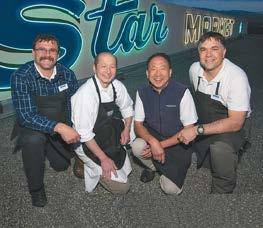




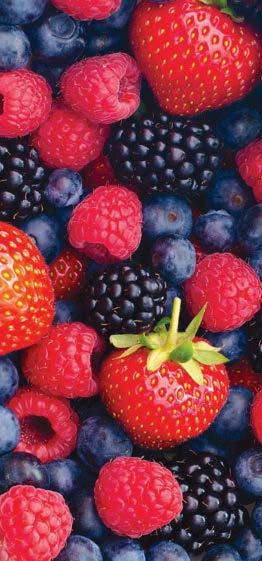



















www.ediblemontereybay.com 5 F ding our co uni with love, generosi , integri & kindne OPEN 11AM-9PM EVERY DAY ALL ORDERS TO GO Order online at charliehongkong.com Curbside pickup · Walk-in · Phone orders Safety is Our Top Priority · Social Distancing & Masks Required 831.426.5664 · CHARLIEHONGKONG.COM 1141 SOQUEL AVE, SANTA CRUZ · OPEN DAILY 11AM-9PM 1275 S Main St Salinas starmkt.com Delivery & Curbside Pick Up Now Available! THE FRIENDLY STORE LOCALLY OWNED FOR OVER 50 YEARS LOCALLY OWNED FOR OVER 50 YEARS From Monterey to Santa Cruz, there’s a new locally-owned, best choice for clean eating and healthy living. Come explore our new Watsonville location. The largest selection of Organic Food and Supplements on the central coast. www.staffoflifemarket.com SANTA CRUZ 1266 Soquel Avenue 831-423-8632 TWO LOCATIONS TO SERVE YOU OPENING MARCH 30, 2021: WATSONVILLE 906 E. Lake Avenue • 831-726-0240 www.LiveEarthFarm.net G JOIN OUR YEAR ROUND CSA! Customizable shares Fresh bread, eggs, honey and preserves available S Discounts New members receive $10 off your first , use code HEARTBEET at sign up.
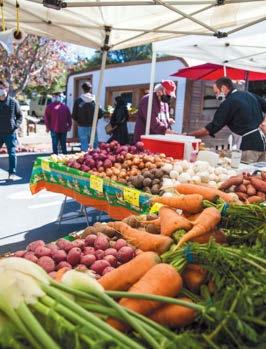

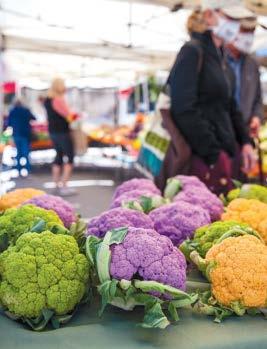

6 edible MONTEREY BAY SPRING 2021
EDIBLE NOTABLES FRIENDLY POSH
Carmel-by-the-Sea Farmers’ Market comes into its own
BY KATHRYN MCKENZIE PHOTOGRAPHY BY MARGAUX GIBBONS
To the casual observer, it seems like Carmel and farmers’ market should go together like organic peanut butter and artisan-made jelly.
After all, in this foodie paradise, a weekly marketplace offering the best in local produce, baked goods, fresh flowers and boutique gifts would be a no-brainer, right?
But despite being in its ninth year, it’s only been recently that the Carmel-by-the-Sea Farmers’ Market has come into its own as a one-stop shopping experience.
On a recent unseasonably warm Thursday, you could hear the market even before you saw it. The buzz of conversation and live
guitar music accompanied delicious aromas of coffee, baked goods and fragrant narcissus wafting through the air. Even though shoppers were masked and socially distanced, it was evident from their joyful attitude that walking through the market was giving them a much-needed respite from sheltering in place.
Last year, Good Roots Events took over management of the market. It is now being cultivated and curated by Good Roots founder Nile Estep and event manager/farm liaison Raul Lopez, who both grew up in Monterey County and have a deep love and knowledge of artisan-crafted products and certified organic produce.
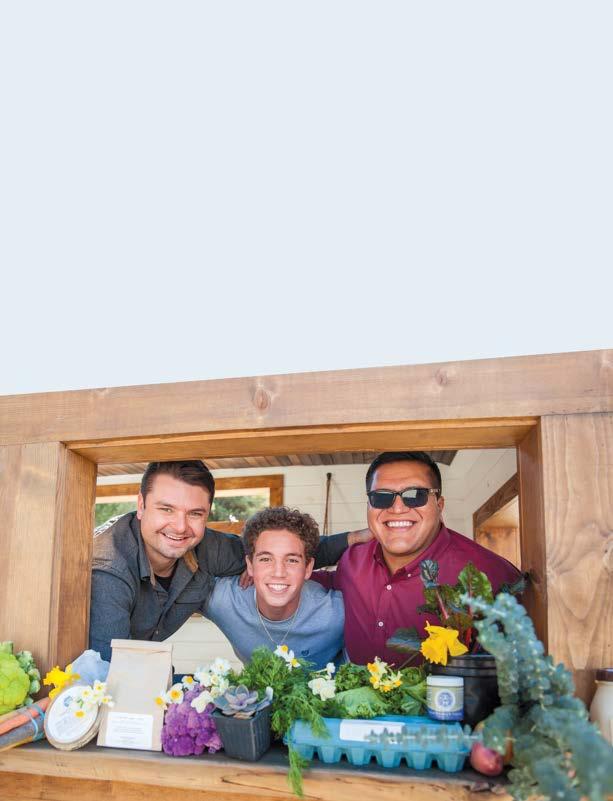
www.ediblemontereybay.com 7
Working the information booth are (left to right) Good Roots founder Nile Estep, assistant market manager Chase Jones and market manager Raul Lopez.
“It’s really special for us to be part of this community, offering a place where people can safely gather and shop in the sunshine,” says Lopez, who got into farmers’ markets originally as a produce vendor.
Adds Estep, “We want this to have a boutique feel, but also to be welcoming to all members of the community. It’s a place where everyone’s invited.”
“A friendly sort of posh,” Lopez chimes in.
Estep, a 2009 graduate of Carmel High School, also got his start as a vendor at a farmers’ market selling gluten-free baked goods. After college and an internship with the American Red Cross, he rediscovered his passion and ended up taking over management of the Portola Valley Farmers’ Market. Now, his company Good Roots is making a difference—not just through its event planning, but also by taking farmers’ markets directly to the campuses of giant tech companies like Tesla and Facebook. Additionally, Good Roots gives back to surrounding communities by providing meals to those in need through churches, senior centers and community groups.
Estep is deeply committed to making sure people get fed, particularly underserved communities. Growing up as the child of a single mother who was a chef at the National Steinbeck Center in Salinas, Estep remembers their struggles to stay afloat, but he also says his mother made it a point to introduce him to a wide range of wonderful foods. “I want to make more local products affordable and accessible to more people,” Estep says. “Everyone should have access to good healthy foods.”
Taking on the Carmel-by-the-Sea market gives him an excuse to visit family more often as well as an opportunity to expand his business reach. For the city, it’s been a much-needed solution to ongoing issues with the market’s management.

Victoria Beach, the former Carmel City Councilmember who in 2012 led a committee to organize the farmers’ market, says the weekly
event has been a work in progress over the years. The city had to move the location several times from its original spot in the Sunset Center parking lot. More problematic in previous years, she says, was that “we did not have management that believed in our vision.”
Even though the enterprise has had its growing pains, locals have appreciated having a farmers’ market in the heart of downtown Carmel.
“The community has been really thrilled to have it. They’ve been so supportive,” says Beach, who makes it a point to shop at the farmers’ market each week. Now, she says, with a young, energetic team at the helm who understand branding and establishing a clear identity for the market, “we’ve seen so many of the elements of our original vision come to fruition.”
That includes well-rounded offerings of organic produce, breads and pastries, live plants and flowers, local meats and seafood, eggs, cheeses, coffees and other blended drinks, honey, sweets and gift items—with emphasis on the bounty of the tri-county area. Among the well-known names at the market are Ad Astra Bread Co., Nitro Cycle 831, McLellan Botanicals and Coke Farm, with others such as Lion Springs Lavender Farm of Carmel Valley, and Bees Knees Bakery and Big Paw Olive Oil Co., both of Hollister, sure to become future favorites.
There’s also a joyful throwback vibe about the market—from the musicians providing a happy audio backdrop to the vintage trailer that doubles as an information booth, and numerous hand-lettered chalkboard signs pointing the way.
Just as important, says Beach, is the opportunity for local groups to make the market an information hub where residents can get help with everything from composting to voter registration.
That’s a concept that will be expanded later this year. Estep is now in talks with the city to hold a quarterly community event in Devendorf Park, right next to the market, to provide space for more organizations to get their message out to the public and other special activities in conjunction with the farmers’ market.
Estep and Lopez are appreciative of the support they’ve gotten from the city and residents, and are looking for ways to make the market even better going forward. They are choosing vendors based on “how they fit into the ecosystem of the market,” as Lopez puts it, and they’re looking forward to the warmer months when outdoor markets really shine.
For Beach, she’s just happy to be able to find her favorite fresh seafood at the market each week, as well as beautiful baskets of mushrooms at the Fungi Temple booth and local organic salad greens. Her daughter immediately runs to the Nitro beverage cart when they visit, and Beach welcomes the chance to say hello to people she knows.
“I saw an old and dear friend recently at the market, and it was so exciting—I hadn’t seen her for so long. We talked for 45 minutes in the street,” says Beach. “The social aspect is irreplaceable.”
Carmel-by-the-Sea Farmers’ Market Mission at Ocean, Thursdays 10am–2pm goodrootsevents.com
Santa Cruz native Kathryn McKenzie, who now lives on a Christmas tree farm in North Monterey County, writes for numerous publications and websites. She recently co-authored the book Humbled: How California’s Monterey Bay Escaped Industrial Ruin.
8 edible MONTEREY BAY SPRING 2021
Mark Oshana Badal of Fabrique Délices offers local cheeses and charcuterie.
CONNECTED COLLABORATION





Another project from the energetic Niles Estep is a new creative space in Monterey called The Shop—which has become a cauldron of creativity encompassing everything from food to crafts to visual arts. Launched last year with partners Jessica Ansberry and Chris Powers, The Shop is a buzzy blend of collaboration and community, with food purveyors such as Nitro Cycle 831, MylkMaid, Little Luna Cheese Boards, Coastin Pizza and Parsley+Fig taking their businesses to the next level in its commissary kitchen.

The Shop also offers valuable work space to artisan crafters like Johnny Foster, who sells his fragrant soy candles at the Carmel-by-the-Sea Farmers’ Market, and to artists-in-residence like Sophia Eliana, Mike Mattox and Arsenio Baca, among others. Podcasts and videocasts are being recorded in a brand-new studio as well.
Estep says much of what is done at The Shop feeds into his farmers’ market business, with designers and printers available there as well as food and craft vendors who are looking for markets where they can sell their products.
For Mike Baroni, owner of the mobile drink cart Nitro Cycle 831, The Shop gives him the room he needs to bottle his products—something his one-man business wasn’t able to do previously.
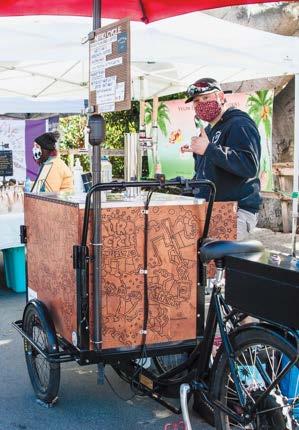
Baroni has introduced bottled matcha, oat milk latte and guava lemonade, among other drinks, which could be sold at local grocery stores and other retailers. Not only that, bottling offers the chance to do some new and exciting beverages: “It’s a way to kick things up a notch.”
Estep says his goal is to make the space accessible and affordable, renting it on a sliding scale depending on the hours it’s used. “It’s a place where food creators can test out an idea, and then I can help them find a place where it can be sold,” he says.
The Shop 1271 10th St., Monterey theshopmonterey.com
www.ediblemontereybay.com 9 @BLADETECHUSA
Mike Baroni of Nitro Cycle 831 is a farmers’ market favorite.























10 edible MONTEREY BAY SPRING 2021 DIGGARDENS.COM SANTA CRUZ 420 WATER STREET (831)466-3444 APTOS 7765 SOQUEL DRIVE (831)688-7011 Now Open in Monterey We’ve been serving the Monterey and Salinas markets for with the opening of our downtown Monterey branch. Rich Aiello and his team are here to serve your banking needs with resourceful, relationship-based expertise. Give them a call. Visit us online. Or mask-up and drop by. We look forward to getting to know you, and making a SCCOUNTYBANK.COM 831.242.8361 Rich Aiello, SVP Regional Manager 831.457.5003, x 2801 584 MUNRAS AVENUE APTOS CENTER 7552 SOQUEL DRIVE 831-688-2799 CARMEL BY THE SEA OCEAN & MISSION 831-624-5621 Visit our two store locations:
EDIBLE NOTABLES STRONG START
Calavera Coffee brings the hip factor to Hollister
 BY RAÚL NAVA PHOTOGRAPHY BY MICHELLE MAGDALENA
BY RAÚL NAVA PHOTOGRAPHY BY MICHELLE MAGDALENA
Evan Morris sets two rules for his employees at Hollister’s Calavera Coffee—be nice and make good coffee.
Those guiding principles have been instrumental in the shop’s success sitting in the shadow of a Starbucks across the street.
Though it’s reviled by most in the specialty coffee industry, Morris actually credits the chain for sparking his interest in coffee. “Even though people see Starbucks as competition, I’ve learned a lot from them because they’re the ones who set the tone and example for our industry.”
Morris confesses he has a personal history with the corporate coffee chain, having scored his first job as a barista at a local Starbucks during his senior year of high school.
But it was local roaster Vertigo that showed Morris coffee could
be a craft, not just a business. His brother Ryan convinced Morris to join him at the San Juan Bautista coffee roasting company.
“It opened my eyes to a really different way of doing coffee that I didn’t really get at Starbucks.”
More so, it inspired his dream of entrepreneurship.
Morris bounced back and forth between various jobs while studying at local community colleges, but was unsettled on what to do next. “I didn’t want to work corporate,” he says, “but I liked working for a small business.” He dropped out of school and returned to coffee service—this time starting his own café. “I’d always wanted to own a small business. I just didn’t know I’d open a coffee shop.”
Calavera kicked off in 2018, sharing space inside The GardenShoppe in downtown Hollister. After a three-month
www.ediblemontereybay.com 11
residency there, Morris moved the operation to Farmhouse Café, becoming a permanent pop-up inside the restaurant.
In March 2020, Morris signed the lease for Calavera’s first café— and then the pandemic triggered shelter-in-place orders the very next day. He’d already begun to move out of Farmhouse Café, so Calavera spent the next four months in hibernation. Morris continued work behind the scenes, navigating the ebb and flow of restrictions, and after careful consideration, finally opened the shop at the end of July.
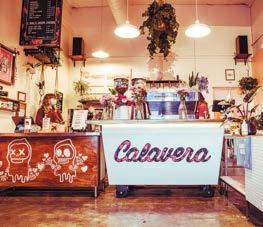

Many independent coffee houses have gravitated toward a signature look—white walls, subway tiles, rich woods, cement floors—a sterile space intended to showcase coffee without distractions and spotlight product not personality. But Morris purposefully broke that mold with Calavera’s first standalone café. “When you walk in, it’s very different.” The coffee shop makes a splash with bright pink walls, namesake skulls (or “calaveras” in Spanish), floral wallpaper, plants and loud music spinning on vinyl. “We want to be ourselves.”

12 edible MONTEREY BAY SPRING 2021
Morris aims to serve coffee from every state and he’s checked 11 states off his list so far.
Owner Evan Morris (above with beanie) and crew offer a rotating menu of specialty coffee drinks that keeps customers coming back.
Inclusivity is important for Morris. “We always try to be friendly to everybody and be as welcoming to everybody as possible. That’s the culture we have.” Morris recognizes coffee shops can be intimidating, so he’s purposeful in making the space and menu feel light and playful instead of stuffy and serious. There are tongue-in-cheek names and rotating seasonal drinks that welcome more casual coffee consumers to the fold.
Don’t take that playful nature as a sign Morris isn’t serious about coffee. He’s carefully considered and curated each roaster he features.
Cat & Cloud from Santa Cruz and Vertigo from San Juan Bautista are staple selections, but each month also sees a new guest roaster. Morris looks for artisan producers committed not just to their craft, but also their community. Favorites have been Onyx Coffee Lab in Arkansas— “I’d been trying to get their coffee for two years”—and Brandywine Coffee Roasters in Delaware—“They do a lot of coffee for a cause and have a good culture behind what they do.” Morris aims to serve coffee from every state and he’s checked 11 states off his list so far.
But seasonal craft concoctions have become Calavera’s signature.
“The seasonal drinks are always a little bit fun,” says Morris. “We’re intentional about how we design drinks. We want to have unique options other places won’t have.”
Morris’ past favorites have included The Villain—a brew with housemade coconut cream and dark brown sugar named in honor of the late rapper MF Doom—and the Cardi P—a cardamom-pistachio latte, so named because after his first sip, Morris exclaimed, “Oh, wow” in a tone reminiscent of one of rapper Cardi B’s signature catchphrases.
Each enjoys a limited run and selections won’t repeat, so regulars closely follow menu drops on Instagram for their taste of new drinks.
Like many coffee shops, Instagram has been crucial in helping Calavera find new customers when the pandemic has reduced foot traffic and forced businesses to pivot to digital, instead of physical, engagement.
Morris hasn’t let the pandemic dampen his vision for coffee and community at Calavera.
Like many businesses, he’s diversified revenue streams, adding merchandise. Morris enlisted the creative talents of his baristas, establishing profit sharing from sales of mugs, shirts and more featuring their art. It’s a win-win that keeps the staff employed and helps customers feel more connected to the brand.
But Morris is less concerned with profits than with people. “As a company, we’re a very customer relations-oriented business,” he emphasizes.
Above all, he hopes Calavera can offer respite to a community ravaged by the pandemic. “The quality of coffee is important, but the most important thing is how we treat people,” he says. “As long as we’re nice to people and give them good coffee, we’ll find our way through it.”
Raúl Nava (he/him/él) is a freelance writer covering dining and restaurants across the Central Coast. Follow him on Instagram and Twitter: @offthemenu831.
Calavera Coffee calaveracoffee.org
1709 Airline Highway, Ste. M, Hollister
LA POSTA OSTA WEDNESDAYTHROUGH SUNDAY!
LAPOSTARESTAURANT.COM




SERVING
DINNER PATIO
ON THE ONTHE

HOURS: 5pm-8pm
SOIF WINE BAR W WEDNESDAYTHROUGH SATURDAY! SOIFWINE COM 831-423-2020


www.ediblemontereybay.com 13
EDIBLE NOTABLES HOME COOKING
In a new cookbook, chef David Kinch shares the dishes he loves to serve friends at his home in Santa Cruz
BY LAURA NESS PHOTOGRAPHY BY AYA BRACKETT
Thank Tuesdays and vinyl for David Kinch’s new cookbook, At Home in the Kitchen: Simple Recipes from a Chef’s Night Off, due out March 23 and conceptualized long before the pandemic, back in July of 2019. The 154-page book began as Kinch’s way to share the communal bliss of friends gathered in a busy home kitchen, doing what they do best: cooking. Not as a job, but as an outpouring of the sheer joy of food, of love, of sharing. Centered on music, wine, food and laughter-filled gatherings, the book reveals more than the secrets to simply prepared, satisfying meals; it is itself a recipe for a life well lived.

Kinch told us in a chat from his beloved Mentone restaurant in Aptos in January that he was eagerly awaiting the first copy of his book to arrive. Most of the 120 recipes that appear in it were gathered during his 40 years as a chef, inspired by the many places the journey has taken him, and were frequently prepared for Tuesday gatherings at the Pink Palace—his home near the beach in Santa Cruz. Mondays and Tuesdays are typically the chef’s days off, and Tuesday is his Sunday, the day he loves most, and the day he likes to cook fun dishes for his friends, and for himself.
“I wanted to do another cookbook, but didn’t want it to be like the first,” Kinch told us, referring to the tome, Manresa, an exacting reflection of how food was painstakingly prepared in his three Michelinstarred kitchen in Los Gatos. Instead, Kinch wanted this book to reflect the casual side of cuisine, approachable and sharable, or a way to feed oneself righteously at 2am.
“For this book, our mantra was no more than five or six ingredients per recipe. And they all had to be easily sourced,” says Kinch, who loves frequenting farmers’ markets. The recipes are specifically brand agnostic. He’s made them hundreds of times, from memory, and admits it was sometimes a challenge to specify ingredient quanti-
ties, as he is a visual cook. “Butter the size of a walnut,” for example, was one of his grandmother’s measurements that stuck with him. The ingredients and the dishes are simple: things that bring him joy.
As the forewords by chef Dominique Crenn and co-author Devin Fuller eloquently state, this book reveals the heart of Kinch: the man behind the Michelin stars. One of the world’s top chefs, he enjoys nothing more than gathering colleagues and neighbors at his home in Santa Cruz, where he lives to be close to the surf.
At Home in the Kitchen shares many tidbits from his culinary odyssey, from cooking with his grandmother while growing up in New Orleans to his first job at the fabled Commander’s Palace. Kinch teaches how to properly shuck an oyster, peel a tomato, poach an egg, revere basil, grate ginger and dice vegetables, but the book is not about technique as much as it is about being present in each step. Crack eggs on the counter, not the edge of the bowl, he advises, so bits of eggshell don’t get into the dish.
Recipes like Raw Fava, Chickpea & Tahini Hummus, Braised Lettuce & Smoky Bacon, Summer Squash with Canned Sardines and Whole Roast Cauliflower with Capers & Egg are clearly meant to delight and uplift, and not intimidate. He invites you to pay attention and learn, to better enjoy the process and the results.
The book, which he narrates thoughtfully and conversationally throughout, is just a flipping fun, yet touching read. What sets it seriously apart is the constant thrum of music as each recipe comes with a song pairing suggestion.
While the surf may provide sufficient background music for some, for Kinch, it is the essence of life, as much as food. His music pantry is rather like his kitchen one, filled with staples, but with a personal twist. In the pantry, you’ll find chicken stock, chickpea stock, Parmesan stock, sardines, capers, pickles and garlicky herbed croutons.
14 edible MONTEREY BAY SPRING 2021

www.ediblemontereybay.com 15
David Kinch out in front of the Pink Palace—his home in Santa Cruz—where he perfected recipes in the new cookbook.
No more than five or six ingredients are required for any recipe in the cookbook.
In his music stash, you’ll find Ella, Coltrane, Cash, The Kinks, Donna Summer, John Lee Hooker, Blondie, Miles Davis, Buck Owens and The Rolling Stones. “Not much after 1984,” he says. And don’t look for CDs because he’s a vinyl man. “I’m not surprised by the revived interest in vinyl. It’s the best quality, by far. Anyone who’s into jazz and classical understands the depth and clarity from vinyl cannot be duplicated digitally.”
Music appeals to the higher order of senses that makes one truly human. He likens music to food, because you consume it and it feeds you. “It’s not like art. Music and food become part of you. You can feel it, and it becomes a memory.”
The song-pairing element for the cookbook came naturally. “There is always a lot of music playing and people going in and out of the kitchen, cooking, laughing, eating. Sometimes—a lot of times—we end up dancing.”
His Mother Sauce Mayo, for instance, pairs well with “Let’s Stick Together,” by Wilbert Harrison, while Smoked Eggplant Caviar is a natural with Patti Smith’s “Soul Kitchen.” A playlist is due to be released along with the book.
While Kinch may not have a favorite musical artist, he does have a favorite dish: roast chicken. He swears he learns something new each time he cooks it. Which is precisely the point. Keep learning, keep experimenting, keep listening, keep living, keep loving.
It’s a simple recipe for simple, everyday rewards.
Laura Ness is a longtime wine journalist who contributes regularly to Edible Monterey Bay, Spirited, Los Gatos Magazine and Wine Industry Network, sharing stories of the intriguing characters who inhabit the world of wine and food.

Salmon with Soy & Ginger
From At Home in the Kitchen by David Kinch
This simple gingery and garlicky salmon is unassuming, but sneakily delicious. It’s one of those dishes you learn to make once—and it sticks with you for life. Be sure to use a low-sodium soy sauce or the salmon and bok choy will both be too salty. Kinch guarantees, “If you make this for your friends, they’ll see it come together in 20 minutes and then ask for the recipe.”
6 heads baby bok choy 1 tablespoon sunflower oil 2-inch piece fresh ginger, peeled and finely diced 3 cloves garlic, finely chopped ½ cup “lite” or low-sodium soy sauce 1½ pounds salmon fillet, cut into four equal portions
To prepare the bok choy, remove any tough outer leaves. Trim off the bottom stem and tops, being careful not to trim the stem too high or it will fall apart. Cut each head in half lengthwise.
Heat the sunflower oil in a large pan on medium heat. When the oil is shimmering, place the bok choy, cut-side down, in the pan. Cook, nudging the bok choy every so often to prevent sticking, until the bok choy has browned and caramelized at the bottom, about 5 minutes.
Turn the heat to low and add the ginger, garlic and soy sauce. Gently stir to combine, keeping the bok choy cut side down. Cover the pan and simmer until the bok choy has cooked through, about 5 minutes.
Remove the bok choy and set it aside. With the heat still on low, place the salmon, skin-side down, in the pan and cover. Cook for 5 minutes, then uncover the pan and tilt it so the soy sauce pools at the bottom. Use a spoon to ladle the soy sauce, garlic and ginger over the top of the salmon to baste it. Return the bok choy to the pan, cover and continue to cook until the salmon is cooked through, 5 minutes more.
Transfer the salmon to a cutting board. Carefully remove the skin, if desired. Serve the salmon with a spoonful of the soy ginger sauce and a head or two of bok choy. Serves 4.
Pairs well with “Elevator Operator” by Gene Clark with The Gosdin Brothers.
Reprinted with permission from At Home in the Kitchen by David Kinch, copyright 2021. Published by Ten Speed Press, a division of Penguin Random House, LLC. Photographs copyright Aya Brackett
16 edible MONTEREY BAY SPRING 2021
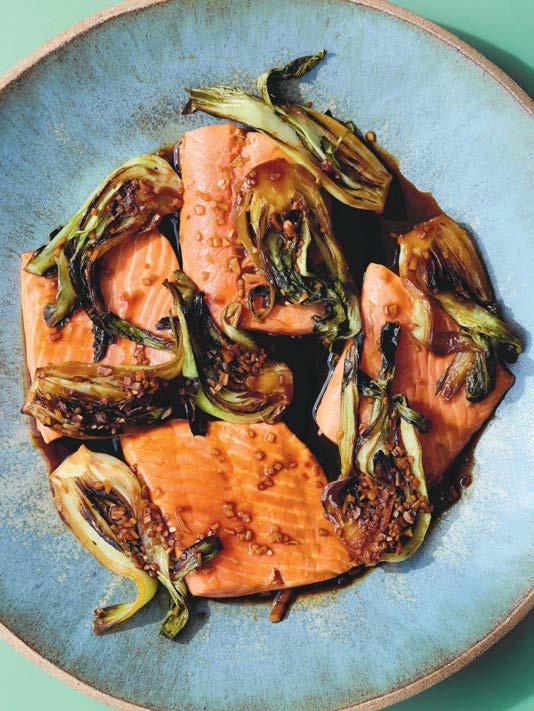
www.ediblemontereybay.com 17
Success Starts With Great Soil
G&B Organics soils and fertilizers are made from high-quality ingredients that are people, pet, and planet safe.









Available ONLY at Independent Garden Centers




Aptos Landscape Supply 5035 Freedom Blvd. Aptos, CA 95003 (831)688-6211









Bokay Nursery 30 Hitchcock Road Salinas, CA 93908 (831)455-1868
Del Rey Oaks Gardens 899 Rosita Rd. Del Rey Oaks, CA 93940 (831)920-1231
Dig Gardens
420 Water St. Santa Cruz, Ca 95060 (831)466-3444

7765 Soquel Dr. #A Aptos, CA 95003 (831)688-7011

Drought Resistant Nursery 850 Park Ave. Monterey, CA 93940 (831)375-2120
Far West Nursery 2669 Mattison Lane Santa Cruz, CA 95062 (831)476-8866
The Garden Company 2218 Mission St. Santa Cruz, CA 95060 (831)429-8424
Griggs Nursery
9220 Carmel Valley Rd. Carmel, CA 93923 (831)626-0680
M.J. Murphy Lumber 10 W. Carmel Valley Rd. Carmel Valley, CA 93924 (831)659-2291
Martins’ Irrigation 420 Olympia Ave. Seaside, CA 93955 (831)394-4106
McShane’s Landscape Supply 115 Monterey Salinas Hwy Salinas, CA 93908 (831)455-1369
Mountain Feed & Farm 9550 Highway 9 Ben Lomond, CA 95005 (831)336-8876
The Plant Works 7945 Highway 9 Ben Lomond, CA 95005 (831)336-2212
San Lorenzo Garden Center 235 River St. Santa Cruz , CA 95060 (831)423-0223
GB-Organics.com










Scarborough Gardens 33 El Pueblo Rd. Scotts Valley, CA 95066 (831)438-4106
Seaside Garden Center 1177 San Pablo Ave. Seaside, CA 93955 (831)393-0400
Sierra Azul NurseryGarden 2660 E. Lake Ave. Watsonville, CA 95076 (831)728-2532
Valley Hills Nursery 7440 Carmel Valley Rd. Carmel, CA 93923 (831)624-3482
18 edible MONTEREY BAY SPRING 2021
WHAT’S IN SEASON
RADICCHIO

Bitter and beautiful, learn how to use these stunning vegetables
BY JAMIE COLLINS PHOTOGRAPHY BY PATRICK TREGENZA
www.ediblemontereybay.com 19
On a trip to Italy long ago, I was marveling as a man with strong, weathered hands made short work of trimming artichokes to expose their meaty little heart, when my eyes caught the most beautifully colored vegetables I had ever seen. These odd-shaped aliens in all colors and sizes were various kinds of radicchios and chicories. Some had long magenta fingers with bright, white ribs, some were tender and faint yellow with hot pink speckles and others were yellow with splashes of red. My favorite was a gorgeous light pink color I had never seen in a vegetable before.
Until then, I wasn’t aware of more than one type of radicchio— Chioggia, the round burgundy variety with white ribs. Most people still only know it as the bitter leaf typically found chopped in pre-washed salad mixes, adding depth, color and texture to soft lettuce leaves.
Radicchio is in the chicory family (Cichorium intybus), which also includes dandelion greens, frisée, endives and what is commonly grown for a coffee substitute, digestive bitters, or as an ingredient in brewing—chicory root. All chicories are somewhat bitter, which makes them great companions for acidic vinegars and lemon juice, as well as a foil for sweets like fruit and candied nuts. Fats like olive oil or bacon fat and protein such as anchovies, pancetta or chicken and strong, salty cheeses are perfect additions to radicchio, striking a good balance on the taste buds. My favorite way to eat radicchio is to chop it up and add to a quiche or tart with sweet potatoes or butternut squash chunks and fresh tarragon. The more cream and fewer eggs you use, the more decadent it is. The addition of Gorgonzola or blue cheese makes it even more amazing.
Radicchios are as delicious cooked as they are raw in salads. They can be sautéed and grilled, braised, barbecued, turned into tapenades, cooked alongside pork chops or inside a whole chicken, folded into risottos and pasta or chopped finely on top of pizzas and they are surprisingly good in pastries and cakes.
OLD WORLD HERITAGE
Cultivation began in the 15th century in the Veneto region of Italy. Each variety of radicchio is named after the town in northeastern Italy where it originated. Radicchio started being grown commercially in California in 1981, which surely pleased Italian immigrants in the Monterey Bay area.
Open pollinated, heirloom seed results in many strains of radicchios grown in Italy. However the four main varieties grown on the Central Coast are:
Chioggia – This most common type of radicchio is round with a tight head, white ribs and dark maroon leaves and is about the size of a large grapefruit. The white ribs of radicchio contain the strongest bitter flavor and this one has some of the thickest ribs, which is why this radicchio is best cooked to sweeten the flavor. Try cutting into chunks, coating with olive oil, sprinkling with balsamic vinegar, salt and fresh thyme and roasting in the oven. It is available year-round from Salinas grower-shipper Royal Rose, but smaller farms typically plant in the fall so that a tight head forms naturally in the colder months. Radicchio can be found at farmers’ markets in winter through spring.
Farmer Joe Schirmer of Dirty Girl Produce holds a baby Treviso radicchio. On next page radicchios from J. Marchini Farms, top to bottom: Treviso, Castelfranco, Veneto di Rosa.
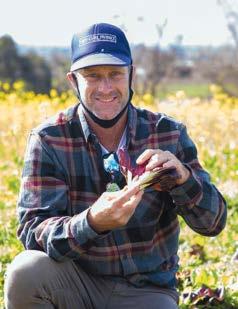
Treviso – This elongated variety looks a bit like red romaine except for the bright white ribs. Treviso is milder than Chioggia and has a softer texture that makes it great for salads. It also can be made into gratins by chopping and tossing with olive oil and Parmesan or Gruyère cheese. In Italy, Treviso is grilled as an alternative to steak, an interesting swap for those vegans in your life.
Tardivo – This variety comes from forcing growth of Treviso after the first harvest when what is left is the root in the ground, causing more flavorful growth. This complicated growing technique is also called fiori d’Inverno or “winter flower” because it causes the plant to grow mostly crisp, with white ribs, tinged with burgundy and lime green colors, which look like long fingers. Tardivo consists of mainly white ribs that are more hearty and crisp and of course more bitter than the original plant. Tardivo is great sautéed with shallots as a side dish with olive oil. Consider adding some olive tapenade, Asiago cheese, segments of sweet mandarins and pop it on top of creamy polenta.
Castelfranco – This variety is very tender and looks somewhat like a butter lettuce crossed with a rose, making it the gateway radicchio. The leaf color varies from creamy yellow to almost white to green and light pink, however, all have specks of red. This variety is the most mellow, sweetest type of radicchio, although it is still somewhat bitter. Use this variety in salads or as an appetizer, cupping a smidge of something delicious like pears and goat cheese.
20 edible MONTEREY BAY SPRING 2021
Veneto di Rosa – This variety is bubble gum pink in color with white ribs that are pleasantly sweet. The leaves are the most mild of all the varieties and have a floral element. It is rare to find a vegetable of such a color that is as delicious as it is gorgeous. In a salad, the color sets off the other ingredients, while the flavor rounds out sweetness or richness of cheese. I recently made what I called a “desert salad” using the Rosa variety, adding goat cheese, ginger and maple candied walnuts, raspberries, mandarin slices and some spinach leaves. I can’t get enough of the Rosa variety—my next salad will be a gorgeous pink wedge with blue cheese!
RAD RADICCHIOS
After my visit to Italy, I was motivated to grow a few open pollinated varieties of radicchio. The bitter greens did not sell very well for me at the farmers’ markets, and the restaurants I sold to didn’t need enough to make it worthwhile, so I stopped growing them. But Watsonville organic farmer Joe Schirmer of Dirty Girl Produce has a perfect location for the cool weather crop as well as a strong market for them. Even with restaurants closed due to COVID, he is able to sell significant quantities to culinary savvy customers at the farmers’ market. He currently grows three kinds of radicchio on his farm, Chioggia and Treviso, and occasionally Castelfranco. Other varieties he grows—Pan di Zucchero and Puntarelle—are technically chicories and only available in fall. One of the problems Schirmer has growing radicchios, besides rabbits wanting to eat them, is that market customers often buy radicchio thinking it is cabbage or lettuce and come back saying that it was the worst cabbage or lettuce they have ever tasted!
Schirmer loves radicchio both as a farmer and as a cook; he appreciates it in his winter crop rotation, even if it is a “moody” plant to grow. His favorite way to eat it is simple: He cuts it in half, coats it in olive oil and balsamic vinegar and roasts it in the oven at 350° F until the tips blacken. Cooking it sweetens the bitterness. His kids say their favorite part is the yummy “nugget” where the leaves grow out at the base of the head.
GROWING RADICCHIO
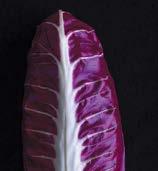

Radicchio is fickle if not grown during the time of the year it prefers. It is happy when planted in fall and harvested through the winter and spring. In this way there is time to form a head naturally. If growing
open pollinated, heirloom varieties from Italian seed companies like Franchi or Levantia, it is crucial you plant at the proper time. There are some hybrid varieties that can be grown year-round, but the seed is expensive and perfect growing conditions are required to get a good crop.
Radicchio can be direct seeded into the garden, covered lightly with soil, and once it emerges, thinned to a spacing of 8 inches apart. Radicchio seeds germinate best at 75° so depending on the microclimate, it might be best to sow some seeds in the greenhouse first. Space plants 8 inches apart and in rows 12 inches apart. Keep soil moist so that it stays cool. If the soil dries out, radicchio gets more bitter. It takes 90 days from seed to harvest. Harvest with a sharp lettuce knife at the base of the plant when plants look full and seem heavy.
TO YOUR HEALTH
The reddish purple pigment in radicchio makes it an antioxidant superfood, in the same category as blueberries. Better yet, radicchio has no sugar whereas berries do, so you get those prized anthocyanin nutrients said to ward off cancer and heart disease, without increasing your blood sugar. Bitter vegetables in general stimulate digestion by increasing saliva which thereby increases digestive enzymes. Bitters also trigger the production of stomach acid, which may lead to improving the absorption of food. These compounds as well as the significant amount of fiber in radicchio are also good food for your gut bacteria, and we know that the gut affects our mood so best to keep our good microbes happily fed. If that weren’t enough to convince you to eat radicchio, it also contains loads of calcium and vitamins K, C and E.
When buying, look for radicchio that feels heavy for its size with robust, brightly colored leaves. Be sure it has a tight head that is not too small or too light. That means it is old and the leaves have been trimmed and peeled back many times to keep the heads looking good enough to sell.
Store your radicchio in the coldest part of your refrigerator in a bag with the air removed and closed well. As radicchio ages, it gets more bitter but don’t fret. If you want to remove some of the bitterness, cut and soak in water, rinse and drain well before eating or cooking.
Jamie Collins is the owner of Serendipity Farms and attends all of the Santa Cruz Community Farmers’ Markets, where you can find her fresh organic fruit, vegetables and nutrient-dense prepared food items.

www.ediblemontereybay.com 21
Radicchio Salad with Citrus Vinaigrette
Courtesy Ben Spungin, chef-partner, Alta Bakery + Cafe in Monterey
Alta Bakery + Cafe in Monterey has a radicchio salad on the menu that showcases its bitter flavor by pairing it with apples, candied walnuts and lots of shaved Parmigiana-Reggiano. Spungin says he loves the bitterness of radicchio and is excited to be able use it more— blanched, grilled and roasted—once his upcoming restaurant, Cella, opens across the courtyard in the charming Cooper Molera Adobe.
Chioggia radicchio Castelfranco radicchio Candied walnuts Apples, sliced Parsley, chopped Parmigiano-Reggiano, grated Citrus vinaigrette
Tear radicchio into bite-sized pieces and toss with walnuts, apples, parsley and vinaigrette. Top with grated Parmigiano-Reggiano.

For the vinaigrette 2 cups orange juice ¾ cup apple cider vinegar
¾ cup golden balsamic vinegar
1½ tablespoons honey
2 tablespoons Dijon mustard
1 tablespoon shallots, minced
1½ teaspoons garlic, minced
1¾ cups olive oil
Salt and pepper, to taste
Put all ingredients together in blender, except the olive oil, and mix. Add olive oil in a stream to emulsify. Add salt and pepper to taste. It’s always best to taste vinaigrettes with the lettuce or, in this case radicchio, that it will be used with. Makes 1 quart.
22 edible MONTEREY BAY SPRING 2021
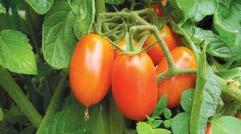
















www.ediblemontereybay.com 23 Design • Installation • Maintenance License #656636 Bring the outdoors in with edible landscaping! terranovalandscaping.com | 831.425.3514 We’ll help you grow during all four seasons. ECOLOGICAL LANDSCAPING FIRSTCERTIFIEDORGANICRETAILERINTHEUSA FAMILYOWNED&OPERATEDFOR30YEARS 10%PROFITBACKTOTHECOMMUNITY WWW.WILDROOTSMARKET.COM 6240HIGHWAY9 FELTON,CA 13159CENTRALAVE. BOULDERCREEK,CA
LOCAL FOODS IN SEASON MARCH, APRIL

AND MAY





FRUITS
Apricots* • Avocados • Blackberries* • Cactus Pears* • Grapefruit** Kumquats** • Lemons • Limes** • Mandarins** • Oranges • Pomelos** Rhubarb** • Strawberries
Vegetables
Artichokes • Arugula • Asparagus • Beets • Bok Choy • Broccoli • Broccoli Raab • Brussels Sprouts • Burdock • Cabbage • Cardoons • Carrots Cauliflower • Celeriac*** • Celery*** • Chard • Chicory • Collards • Cress Dandelion • Endive • Fava Beans and Greens • Fennel • Garlic Horseradish • Kale • Kohlrabi • Leeks • Mushrooms • Mustard Greens Nettles • Onions • Orach • Parsnips • Peas** • Pea Shoots • Potatoes Radishes • Rutabagas** • Shallots • Spinach • Sprouts • Squash Sunchokes • Turnips

Seafood
Abalone • Crab, Dungeness • Grenadier, Pacific • Halibut, California* Lingcod, Pacific • Rock Cod, aka Snapper or Rockfish • Sablefish, aka Black Cod • Salmon, King • Sanddabs, Pacific • Seabass, White Sole (Dover and Petrale) • Spot Prawns • Squid * May only ** March and April only ***April and May only
All fish listed are rated “Best Choice” or “Good Alternative” by the Monterey Bay Aquarium’s Seafood Watch program and are found in abundance in local waters. See www.seafoodwatch.org for more information.

24 edible MONTEREY BAY SPRING 2021














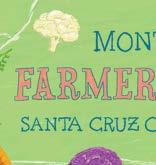





































25








EDIBLE
PROVISIONS
get nutty
AND STYLING BY THE CURATED FEAST
Healthful and universally loved by children, locally-ground nut and seed butters are plentiful around the Monterey Bay, including some sophisticated flavors. Top row: Positively Nutz Sunday Morning Cinnamon Mixed Nut Butter, Positively Nutz Touch of Vanilla. Row 2: Alma Superfoods Yellow Aji Pepper & Cashew Butter, Positively Nutz Chocolate Mixed Nut Butter. Row 3: The Philosopher’s Stoneground Ostara Cocotella, Ostara Stone Ground Coconut Butter. Row 4: The Philosopher’s Stoneground Sprouted Almond Butter, Wise Goat Organics Lion’s Mane Almond Butter, Wise Goat Organics Hazelnut Chocolate. Row 5: The Pistachio Factory Pistachio Butter, Nutty Foodz Choccolata Sunflower Spread. Bottom row: Nutty Foodz Choccolata Almond Spread.
 PHOTO
PHOTO
www.ediblemontereybay.com 27
Rest & Renew in the Redwoods. Travel with Fulfilling Purpose
.
The perfect blend of relaxation, immersive learning and memorable meals, Rest & Renewal packages at 1440 Multiversity are all-inclusive and designed for a variety of interests. Book a savory Teaching Kitchen weekend, a refreshing Explore the Redwoods experience or a custom visit to rejuvenate at your own pace and schedule. Whichever you choose, you will nourish your mind, body and spirit with locally sourced cuisine, popular 1440 Signature Classes and energizing time in nature, while spending the 1440 minutes we are gifted each day just a little differently.
Every booking at 1440 Multiversity feeds a family of four in Santa Cruz County and helps build community. Travel with fulfilling purpose — 1440 Multiversity is committed to helping people Live, Lead, Love, Work and Wonder Well, and we invite you to visit our 75-acre nonprofit campus in the redwoods to create hope for living well. Book now at 1440.org/EMB
Private Events with a Mission
Whether you are looking for an intimate dinner under the stars in Joanie’s Garden or a socially distanced meeting in the redwoods, 1440 offers more than 20 inspiring outdoor meeting spaces to help achieve your learning objectives. Each booking helps keep families nourished in our region.

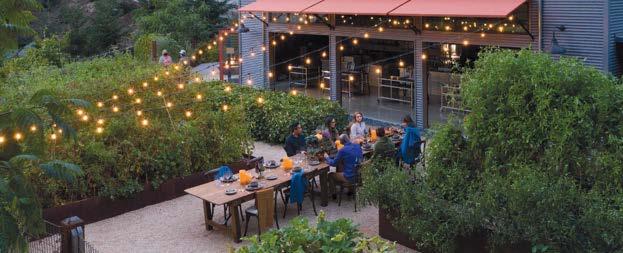
SHOW YOUR SUPPORT
Philanthropic Initiatives


Join our efforts and donate to our flagship programs for healthcare heroes, military veterans, first responders and wildfire victims, or invest in the general capacity of hope. Every dollar given impacts these important causes, allowing participants to begin the path of healing at no cost to them.

28 edible MONTEREY BAY SPRING 2021 1440.ORG/EMB | SANTA CRUZ COUNTY, CA | 1-833-393-7929
ENGAGE YOUR GROUP
Help us create hope in the world
DREAMING OF RETIRING EARLY? HERE’S YOUR PLAYBOOK

Currently trending in the media is the concept of an incredibly early retirement, called the FIRE (financial independence, retire early) movement. News outlets are printing stories of people successfully retiring in their 50s, 40s and even 30s. If you are intrigued by the idea of retiring early, you are probably wondering if moving your retirement date forward is something within your reach. As a financial advisor, I have seen firsthand how much work and dedication it takes to accomplish. But I can confirm that it is possible to retire early – it all comes down to what your dreams are for today, tomorrow and in retirement. Read on for some suggestions for how to assess if an early retirement is in the cards for you.
1. Define your dream retirement. A realistic early retirement plan doesn’t happen by chance. It takes careful planning and deliberate action. Before you can figure out how to make early retirement a viable option, take time to envision the kind of life you want to lead when you leave your primary career. Where will you live? What kind of activities do you plan to pursue? These are the types of questions that will help you define what you want your retirement to be like.
2. Quantify your goal. Many retirees find they spend more money in the early years of retirement because they have more time to travel and pursue hobbies. If this aligns with your retirement vision, be conservative in your estimate of how much money you need each year. Once you have an estimate of how much it will cost, you will be in a better position to map the steps you need to take to save for your future.
3. Decide which income source to tap into first. Once you know how much your early retirement will cost, you’ll want to line up the order in which you tap into your investments. How much income you need, the tax treatment of your investments, and the timing of when you’ll take Social Security are all factors to consider as you map out how you will create a paycheck in retirement.
4. Adjust your saving and spending today. Once you have a clear idea of how much your dream retirement will cost, you can evaluate the potential tradeoffs and sacrifices necessary to make it happen. This will likely require reducing spending while maximizing the amount you are saving.
5. Continue investing for growth. It’s common for retirees to adjust their investment allocation to be more conservative to protect their principal from potential market downturns or increased volatility. While this may make sense for some, it’s important for your portfolio to at least keep on pace with inflation. After all, retirement can easily last several decades. Even modest inflation can make a meaningful impact over that time frame. Factoring inflation into your projections can help you maintain your purchasing power throughout retirement.
6. Don’t overlook health care expenses. Many retirees are surprised by how much of their budget goes toward medical expenses. Don’t be one of them. Make finding health insurance a top priority. And, consider the pros and cons of purchasing long-term care insurance.
7. Be flexible. In life and investing, there are no guarantees. Unexpected events can happen any time, and many have financial implications. Think about what your options are if your savings come up short, such as adjusting your retirement date, spending or perhaps picking up a part-time job, and make sure you have the right insurance in place to cover your various assets.
Retiring early is a big dream. If you want help deciding if or how moving your retirement date forward is realistic for you, meet with a financial advisor. Together you can review your goals, investments, risk tolerance and other factors to help you make retirement decisions with confidence.
Erik Cormier is a Financial Advisor with Cormier Financial Partners, a private wealth advisory practice with Ameriprise Financial Services, Inc. He specializes in fee-based financial planning and asset management strategies and has 13 years of experience in the financial services industry. To contact him, email Erik.Cormier@ampf. com or call 408-472-0757.
Registered office address is 522 Ramona St, Palo Alto, CA 94301.
Ameriprise Financial Services, Inc. and its affiliates do not offer tax or legal advice. Consumers should consult with their tax advisor or attorney regarding their specific situation.
Investment advisory products and services are made available through Ameriprise Financial Services, Inc., a registered investment adviser.


Ameriprise Financial Services, LLC. Member FINRA and SIPC.
© 2020 Ameriprise Financial, Inc. All rights reserved.
File # 2692564: (Approved until 09/2021)
SPONSORED CONTENT
SPRING FORAGING ACCESSING ANOTHER LEVEL
Fin + Forage aims to change perceptions of spearfishing and takes our intrepid reporter on a freediving adventure in Big Sur
 BY MARK C. ANDERSON PHOTOGRAPHY BY GLEN MCDOWELL AND JOE PLATKO
BY MARK C. ANDERSON PHOTOGRAPHY BY GLEN MCDOWELL AND JOE PLATKO
The “catch” involves pre-dawn driving, satellite maps, a drone, pro photographers, a rappel down 250 feet of cliff, nearly two miles of openocean swimming and a dozen spearfishing descents.
The “cook” has its own nuances. Lunch entails swimming ashore for a socially distant, pop-up, chef-driven situation on the sand, made possible by the morning harvest, and schlepping of burners, pots, pans, wine, spirits and a wet bar down a switchback so goodies like brown-butter limpet and a Gray Whale Gin martini can materialize.
In other words, “catch-and-cook” sounds simple enough. Not so much.
So it goes with the startup behind this adventure, Monterey Baybased Fin + Forage, which has a penchant for going “full send,” to borrow from founder and professional spearfisherman Eric Keener’s technical terminology. Full send is also his default setting, and has been since he was an orphaned San Jose biker with a gift for stunts and extralegal business dealings.
Today’s expedition fits into Fin + Forage’s larger goal of spotlighting the best of the booming sport of spearfishing, while educating audiences on sustainable harvesting and cheffing. “Spearo” culture provides sizzle, but it’s the food that provides sustenance.
“Few things in life have more power to unite than food,” reads Fin + Forage’s mission. “Yet for those of us privileged with food security, the act of obtaining, preparing, and eating food too often becomes an afterthought.”
Not today.
BREATHING UNEASY
Before any repels or swells, I must fit into a specialized snugger-thanspandex wetsuit at Bamboo Reef Dive Center. I duck into the human flytrap, claustrophobia activated, and it’s immediately clear there’s no way I’ll fit. A Bamboo staffer promptly makes it rain cold lube on the interior. Now my head and arms squirt through with a satisfying plorrrp
On to safety prep. Giray Armağan, a Turkish engineer who can dive 163 feet deep into the cold, murky, dark depths of the Pacific on a single breath, is familiar with freedive beginners after years as an instructor. He covers how he’ll communicate underwater (with a guttural “grouper call” named after the big fish) and where to point a spear gun (away from divers).
He is most intense about one rule: Don’t look where you’re going. That would be natural on a descent, he acknowledges, but it risks hyperextending one’s throat and spitting blood at the surface. Keep it tucked.
“Like you’re holding a grapefruit under your chin,” he says, emphasizing vertical peripheral vision. “You’ll know when you get to the bottom just fine.”
He adds this: “We’ll be offshore in deep Big Sur, miles from any cell reception.”
Don’t look where you’re going rings ironic because Fin + Forage is very intentional about where it’s heading. With the help of a facilitator friend, Keener and partners Andrew Miller and Ryan Gentry conducted several hours-long design sprints, generating scores of pages on branding, voice and visions for a king tide of Fin + Forage content, policy work and collaborations extending over a 20-year timeline.
The author searches for sea urchins in the depths off Big Sur’s South Coast.

www.ediblemontereybay.com 31
“The social media reputation of spearfishing is big fish or bikinis and booty. We wanted to combat that.”
“That planning seemed like a good thing to do,” Keener says. “The social media reputation of spearfishing is big fish or bikinis and booty. We wanted to combat that.”

Priorities include elevating awareness about overfishing (and overall ocean health) and lowering waste with head-to-tail cooking techniques that maximize bones, heads and organs.

“You fillet enough fish and you realize so much is going to trash,” says Miller, an environmental scientist who studied at Hopkins Marine Station, “and it really seemed like a lot of the talk in the spearfishing community was about three main species when there was a lot out there that was edible and no one seemed to be exploring.”
The planning sessions began in May 2020. As of today F + F has assembled an Avengers-like lineup of divers, photographers, videographers and journalists to contribute to its online platform. Published content includes videos, product reviews, spearfishing tales, original marine biology content, rich imagery and tutorials on things from paring your fresh catch to ranking top dive lights. Dozens of recipes like sweet salt and pepper calamari and coastal foraged cioppino proliferate, along with live chef Q&As, international spearfishermen profiles and a podcast.
“It should be community, adventure and what you do with the fish,” Keener says. “If you’re not focused on that, you’re missing out on a huge portion of the sport.”
So the plan is in place. But to borrow from an old adage, you can’t really know where you’re going until you know where you have been.
BACK TO THE BEGINNING
To reach a remote clutch of refugees hiding from genocidal troops in the jungles of Southeast Asia, Keener and his roommate Rev. Charles Meyers had to do some things.
Recruited to help the Free Burma Rangers by their minister as single, fit and adventurous, they were ultimately smuggled across international borders and rivers, under blankets and ballast, risking long foreign jail time to trek 100 miles with packs loaded with 70 pounds of food and medical supplies. Four days of walking—for which they trained months—led to a camp where they ate vines, beetles and frogs while teaching English and other skills to help the persecuted ethnic minority document wrongdoing and escape hiding to find jobs. (They’re legally bound to shield more details about whom they protected.)
There are other head-spinning parts to Keener’s story: how a broken home pushed him to a nomadic life by 12. How an unfulfilled existence of motorcycles, heroin, sex and street crime (“After my childhood, I was constantly seeking to belong,” he says) moved him to one of faith and service (“a different type of belonging, real belonging”). How his kindasorta first date with his now-wife led them to build a raft out of plastic 55-gallon drums and lumber, and sail it down Utah’s Green River.
In each place adventure did good. The Free Burma Rangers, who committed their lives to death-defying rescues, taught him respect for— and perspective on—personal agency. The rafting trip raised money for
a young girl fighting rare bone cancer.
When his freediving hobby blossomed into a semi-pro obsession— and his skill set and social media following grew—Keener got to thinking: How can I leverage my platform?
TAKING THE PLUNGE
“Most of the spearfishing videos are kill kill kill,” Keener says. “It may be a beautiful dive, but it’s a kill video. We want to focus on other things.”
He rattles off what he calls the stages of hunting: Kill something. Kill a lot of somethings. Kill the biggest something. Kill what you need. Kill only what you need, mindfully, with the least impact possible.
The day’s catch and cook expedition fits into the fifth category. After we meet on a turnout along the deep South Coast, we lube down, suit up and assemble spearguns and catch bags on modified boogie board backpacks. Then the four of us descend one by one over stubborn brush and shifting soil to the pocket beach below, on a line tied to a highway reflector. Photographer Glen McDowell tracks our progress with his
32 edible MONTEREY BAY SPRING 2021
(Clockwise from top right) Eric Keener "drops" to 45 feet in pursuit of a meaty rockfish; seafood stock set to simmer; a kick out through the surf launches the long swim south; Keener and Anderson secure a rock crab on an improvised gear float; chef Colin Moody greets the returning freedive team.
drone, taking photos and alerting us when the line is free.
Once we’ve poked around for some jade in the sand, we’re kicking our long fins through a sizable set of waves. The morning light on the turquoise water seems summoned by fairy mermaids, and more magic awaits below. Visibility unlocks 40 feet of clarity, a rarity, and through it a bloom of pink pyrosomes—little free-floating, tube-shaped colonial tunicates— drifts before our facemasks.
My rentals perform a fraction as well as the squad’s gorgeous custom fins sponsored by DIVR, but mine make for more exercise. Partnerships, it turns out, are an F + F strongsuit, and include industry titans like O.M.E.R. and Ocean Guardian. Our underwater photog, Joe Platko, is both a volunteer partner and a magnet for more collaborations, furnishing stunning images that sponsors love.
The swim south takes us through swaying kelp groves and over remote reefs abundant with a Dr. Seussian assortment of sealife—blue rockfish, olive rockfish, black-and-yellow rockfish, several types of perch and an occasional California sheephead. Huge scallops, as stubborn as


they are meaty, succumb to Armağan’s crowbar-like scallop knife.

Keener, Armağan and Platko all find a meditative resting breath at the surface and then drop as far as 45 feet to scout out low-lying crevices. Fishing in earnest will wait until we’re closer to coming ashore, to prevent the fish drag from slowing our swim or turbo-aging in the sun on top of the boards. I simulate their moves, duck dive and keep my chin tucked until I reach the ocean floor. My senses are unanimous: A mere 25 feet deep feels a world away.
Keener says a good freediver takes what’s coming and goes with it. “You’re not in control, but you can still be effective,” he says. “I love the surge. I don’t try to fight it. I know what’s behind me, I let the surge come and line up the shot in front of me. That might be hard for people who want to be in control.”
We surface and keep kicking. After another hour and a mile, the wait-to-hunt plan has grown dubious. Visibility is trending toward milky. Swells are rising, enough that when I swim ahead, the team loses track, and Keener thinks I might be subletting Davy Jones’ locker.
We do have a rock crab that was nice enough to appear unsheltered atop a shelf of reef, plus the collection of scallops. While I gather seaweed and search for sea urchins—Platko’s advice to descend along a strand of bull kelp helps me conserve air spent kicking—Keener worries we might come back to shore fish free.
www.ediblemontereybay.com 33
On his penultimate drop he deploys an “aspetto” technique, scratching rocks to attract curious fish, then waiting, breath held, at depth, hoping one will emerge from the murk. A big blue rockfish obliges and Keener’s shot is true. Soon the four of us are waiting for a window between the bigger and bigger breakers to beach ourselves awkwardly on the stony shore.
PACIFIC TO PLATE
The haul fills the stylish cutting boards provided by yet another partner, The Rustic Craftsman (aka Lindsey Krezeczowski), and plates from local textile savant, Nicole Pilar. We add mussels we gather from the shallows.
“Yes, there’s a challenge to the ocean: How deep and how long you can dive,” Keener says. “But it doesn't have to stop there. Cooking is hard.”
That thought primed Gentry, Keener and Charlie Robinton to arrange 2019’s Catch and Cook Competition at Monterey Bay Kayaks on Del Monte Beach. Unlike most fishing tournaments, the goal would not be catching the biggest fish but cooking the best dish.

They expected a dozen entrants. Thirty-eight showed for the 6am safety check and returned by the 1pm deadline with a prepared plate. Divers’ families joined a Save Our Shores trash-collection competition that earned an 8-year-old a $500 prize package. Local businesses contributed $15,000 in awards and raffle items. Celebrated Monterey chefs Danny Abbruzzese (Portola Hotel, By The Bay BBQ, Seaside Seafood & Market), Tom Snyder (Seventh & Dolores) and Colin Moody (The Club at Pasadera) judged.
“I didn’t know who the hell they were, but I wanted to check it out,” Moody says. “When I saw what was going on—no bravado, more about family, local identity and conservation, the whole package—I thought it was badass.”
Dishes got surprisingly complex, like the second-place crispy skin grassy rockfish with dirty rice made with 100% wild-harvested ingredients. Moody was so impressed with Shane Wescott’s third place rockfish, wrapped in puff pastry and baked with bricks in the sand, he almost offered him a job.
The event’s organic success inspired Fin + Forage itself and our own version of it on this winter day. Moody, now Fin + Forage’s head chef, is among those who greet us on the South Coast shore. He surveys the spoils and springs into action.
“It’s fun when you don’t know what’s coming,” he says with a big smile.
Moody cleans and gently sautés everything from the crab to the mussels. He thinly slices a big limpet, an abalone cousin. He sears it and some scallops in brown butter. Between the stock and the fruits de mer, Moody uses every bit of the seafood, layering the tender fish and invertebrates over sourdough crumbs, and garnishing with spot prawn shell powder and sea lettuce-infused potato foam. Dish number two is blue rock cod-scallop ceviche with grilled citrus and avocado served with crispy fish skin and sea lettuce chicharrons. (See recipe, page xx.)
While this is happening, sommelier and local event coordinator Toby Rowland-Jones, F + F’s house mixologist, pairs Galante Viognier, Dawn’s Dream Rosé from the Santa Lucia Highlands and his own cocktail creations with the food. Not a bad Pacific-to-plate picnic.
Moody has been around the area—and in and out of the bay exploring and surfing—for decades. He’s seen some things, but never anything
quite like the Fin + Forage menu.
“As chefs we get some foraged things,” he says, “but not stuff like this.”
The next Catch and Cook Competition will expand well beyond Monterey Bay, happening via YouTube, and launching as soon as early March, with a three-month deadline. Categories will range from Best Meal to Best Story to People’s Choice, with celebrity judges like Outdoor Chef Life’s Taku and spearfishing cinematography star David Ochoa joining local judges like Moody.
After lunch, he and I stand on the beach and watch the persisting swell obscure whatever might be on the horizon.
“We know what we want to do and what we want to be a part of,” Moody says. “It’s about holding on to that and being ready with your skills and experience. The path ahead may not be clear, but our intentions can be.”
That thought feels right on time. The uncertainty surrounding coronavirus on land and the ills we’ve caused our oceans can be unnerving, but only seem to inspire and intensify Fin + Forage’s push for engagement and education. It also makes navigating the onrushing future that much more important—and adventurous. A full send is only appropriate.
Mark C. Anderson is a roving reporter, editor and photographer based in Seaside, California. Reach him via @MontereyMCA on Instagram and Twitter. MontereyMCA.
Waterman Martini
Courtesy Toby Rowland-Jones and Good Ship Pip Pip
2 unces Gray Whale Gin ¾ ounce Campari Juice of 1 grilled or fire-roasted tangerine Smoked citrus sea salt
Shake and strain into martini glass rimmed with juice of tangerine and smoked citrus sea salt. Makes 1 drink.
34 edible MONTEREY BAY SPRING 2021
Rockfish-Scallop Ceviche with Crispy Skin and Sea Lettuce Chicharrons
Courtesy Colin Moody, The Club at Pasadera
1 to 2 fresh local rockfish (after spearing preferred)
2 cups rockfish meat, cut into ¼-inch pieces (reserve skin for frying, bones, head and rest can be used for stock)
½ cup local or fresh diver scallops, cut into ¼-inch pieces
¾ cup lime juice (cut limes in half and grill 2 minutes to flavor and release more juice)
Sea salt to cure and season
¼ cup red onion, diced finely ¼ cup ripe tomato, diced finely






2 tablespoons jalapeño or serrano pepper, seeded and diced finely
2 ripe avocados, diced ¼ inch ¼ cup cilantro, sliced thinly
2 tablespoons garlic aioli
White pepper, to taste

Generously sprinkle the rockfish and scallop pieces with sea salt. Toss in bowl and set in the refrigerator while slicing and dicing rest of the ingredients (15–20 minutes).

Pour grilled lime juice into the fish-scallop mixture and mix well. Place plastic wrap right onto and over the surface and put back in the refrigerator for 30–40 minutes or until mixture firms up. Drain lime juice and reserve. Mix all remaining ingredients, careful not to mash the avocado or seafood too much. Add back half the lime juice. Check seasoning and adjust if needed. Fry the fish skin in oil until crisp and serve both with sea lettuce chicharrons. Serves 4.
For Sea Lettuce Chicharrons recipe please see ediblemontereybay.com
www.ediblemontereybay.com 35

36 edible MONTEREY BAY SPRING 2021
EDIBLE COMMUNITY
Taste of Home
While the pandemic keeps us physically distant, a boom of cottage bakeries and residential restaurants brings new faces and new cuisines into the local food community
BY RAÚL NAVA PHOTOGRAPHY BY COLINE LECONTE AND MARGAUX GIBBONS ILLUSTRATION BY JASMINE SENAVERATNA
When the coronavirus pandemic hit last spring, Michelle Lee found herself working from home—but her setup looked considerably different than the typical telecommuter’s.
Lee doesn’t spend her workday plopped in front of Zoom, troubleshooting glitchy Wi-Fi. Instead, she labors over a mixer and worries about the precision of her oven temperature. She’s one of many homebased chefs here in the Monterey Bay area selling food directly from their kitchens to customers.
She started cooking from her home out of necessity. For the past five years, she worked as sous chef and pastry chef at the InterContinental The Clement Monterey hotel on Cannery Row until, like many restaurant workers, she lost her job during the pandemic.
“After I was furloughed back in April, the first thing I felt like doing was making a pie,” Lee recalls. She resolved to be as productive as possible while out of work and had fun geeking out on making the perfect pie and the consummate croissant—but then her furlough became permanent. “I decided I was baking so much at home, I’d try to make money from it.” She launched Michelle Kneads Dough, which offers flash sales for baked “QuaranTreats” like caramel pumpkin pie, Cheez-It toffee and sweet Mexican conchas.
Lee isn’t alone. The pandemic has seen a boom of pop-up businesses offering foods cooked in home kitchens.
A scroll through Instagram reveals an astonishing array: vibrant quesabirria tacos with crimson consomé for dipping, artfully executed mochi doughnuts, towering sandwiches of crisp Nashville hot chicken, bite-sized Vietnamese shrimp pancakes—the list goes on and on.
The chefs and bakers behind these foods come from varied backgrounds. Some are steeped in the hospitality industry—out-of-work chefs and servers looking to compensate for lost income, retired hospitality veterans getting back into the business, ambitious cooks selling from home as market research for new concepts—but many are simply amateur home cooks with a passion for food and service.
A mom selling doughnuts to jumpstart college savings for her young kids, a Latinx couple sharing their passion for vegan Mexican cuisine, a high school student keeping busy over her summer vacation with weekend meal deliveries—these home operations have brought greater equity to food service, making an industry notoriously centered on white men more inclusive for women, people of color and young people.
Eager entrepreneurs face fewer barriers operating out of their homes—most notably skipping the expensive investment in buying or renting commercial property. And the commute is appealing.
BUDDING ENTREPRENEURS
After the birth of their fourth daughter in 2018, Isaiah and Jacquelyn Nickerson naturally wanted to maximize baby bonding time. “We were looking for a way to make the income I’d lose being home [on maternity leave] six to eight weeks or longer,” recalls Jacquelyn. She turned to baking, perfecting her recipe for French macarons and soon Mac City Macarons was born.
Like many cottage food operators, Jacquelyn appreciates the flexibility of baking from home. “I like being able to work directly from home while still being around my family.”
This year, she and Isaiah formally secured a cottage food license to sell their colorful and creative cookie combinations for pickup, pop-ups and at local farmers’ markets, finding a fervent following Isaiah calls their “Mac Family.”
Home-based food businesses have emerged as hubs of community and connection in a time when we’re starved for contact and company.
“Customers appreciate knowing they’re supporting family businesses. The community is right there with you helping you succeed,” says Sandra Ortega, who owns Azúcar Con T with her sister Celeste. The sisters sell homemade, vegan conchitas (mini Mexican sweet breads) frozen to bake in your own oven. “Now more than ever, people are trying to keep their money within the community.”
www.ediblemontereybay.com 37




38 edible MONTEREY BAY SPRING 2021
Otto Kramm, founder of Otto’s Bread Co. in San Benancio, agrees. “The pandemic is a tragedy, absolutely, but it’s brought about a sense of appreciation for everything local. Because of shelter-in-place orders, because of isolation, it’s brought a longing for a sense of community.”
Five years ago, he took up baking as a weekend hobby, supplying friends and coworkers with loaves of sourdough. While working from home during the pandemic in his job in banking, Kramm realized finance didn’t suit him. This January, he took a leap of faith to become a full-time home baker. “It’s inspiring to see others like myself pursue their dreams, especially when those dreams help bring people together.”
While the pandemic has elevated the prominence of home-based food operations, these businesses aren’t entirely new.


Since 2012, cooks and bakers have leveraged California’s cottage food law to sell shelf-stable baked goods, jams and such that they make at home. But perishable foods—namely hot meals like you’d enjoy in a restaurant—were excluded until AB626 was signed into law in 2018.
Also known as the Homemade Food Act, this legislation allows for sales of a wider menu of foods by establishing microenterprise home kitchen operations (MEHKOs), essentially residential restaurants. The legislation was intended to democratize food service, which has a notoriously high barrier to entry, while creating a system for inspections and permits—similar to those for cottage food operations—to allay consumers’ concerns about health and safety.


Critically, however, these home-based restaurants are only allowed if approved by the county. To date, Monterey, Santa Cruz and San Benito counties have not passed ordinances to begin permitting microenterprise home kitchen operations. (See sidebar page 40)
Home cooks clockwise from top right: Michelle Lee; Tuty and Alfian Sani; Otto Kramm; and Jacquelyn Nickerson of Mac City Macarons.
Here on the Central Coast, sales of perishable foods require the use of a commercial kitchen. In truth, many of those tantalizing tastes teased all over Instagram aren’t exactly legal—but that hasn’t seemed
to slow diners’ appetites. All rack up like after like from followers who wait in eager anticipation of pop-up sales that often sell out in a snap.
Locals love the feel-good notion of supporting their neighbors, especially when it means enjoying fresh foods and flavors that aren’t common in local restaurants.
Home pop-ups foster not only a greater diversity of purveyors, but product too. Some showcase dishes that aren’t in demand enough to justify a dedicated brick-and-mortar establishment, some cater to niche diets with vegan, gluten-free and keto selections, others ride on trending tastes with unproven market potential.
INTERNATIONAL FLAVORS
The signature rabokki from Rabokki Wednesdays combines ramen noodles and tteokbokki rice cakes in sweetened, umami-rich gochujang sauce. The dish is popular in Korea’s street food stalls, but largely absent from menus at local Korean restaurants. “Eighty percent of our customers have never tried it before, but then they turn into repeat customers,” explains one of Rabokki Wednesdays’ owners, who requested to remain anonymous since her home kitchen business is unlicensed.
After losing her weekend job due to the pandemic, the stay-at-home mother of a special needs child enlisted her own mother—a retired restaurateur—to help cook and sell hearty Korean street food to earn extra income. But the duo found richer rewards in showcasing their Korean heritage. “I’m excited sharing my mom’s food, and it’s such a great thing seeing her light up at customers’ compliments.”
The murky mess of regulations has created an underground market for homemade foods that’s left operators wary of inviting attention. There are now dozens of MEHKOs in business throughout the Monterey Bay area, but few would go on record to share their experience for fear of attracting scrutiny.
And they’re right to worry.
Media coverage and nosy neighbors put home pop-ups at risk of being outed to local health departments and shut down for operating without proper permitting. In the San Francisco Bay Area, authorities have
www.ediblemontereybay.com 39
ordered several viral home pop-ups to close.
That’s an experience the Sani family is painfully familiar with.
Tuty and Alfian Sani launched Tante Tuty’s Kitchen in September. Tuty ran a homebased daycare, which remains shuttered indefinitely to protect a vulnerable family member in the multi-generational Marina home. Looking to recoup lost income, she and her husband leveraged her passion for food and his experience cooking in restaurants to offer locals a taste of traditional Indonesian cuisine.
“I’ve loved to cook since I was little. My happy time is in the kitchen,” Tuty says. The couple’s daughter Ariyanti helped with operations and the family found growing demand for a cuisine absent from Monterey County’s restaurant scene. “For a lot of people, it was their first exposure to Indonesian cuisine,” explains Ariyanti. “Access to a different cuisine was exciting for our customers.”
Customers’ rave reviews earned Tante Tuty’s Kitchen a feature in a local newspaper last October. But a week after a story celebrating their success as a pandemic pivot, the Monterey County Health Department ordered them to move to a commercial kitchen or shut down operations. “I didn’t know the Monterey County Health Department frequented Instagram, but I guess they do?” quips Ariyanti.
“We were shocked, but not really shocked,” she recalls, alluding to the gray area microenterprise home kitchen operations occupy. She and her parents were disappointed, but motivated to lobby county supervisors to recognize MEHKOs with the goal of fostering greater equity and inclusion in the local food industry.
“It would open doors for a lot of BIPOC [Black, Indigenous, People of Color] folks who want to share their food, who want to cook and who want to help keep their families afloat,” says Ariyanti. “People who are a little less affluent, like people of color who don’t have the generational wealth, they have to start somewhere. They have the passion to create a business, but face a lot of roadblocks.”
Raúl Nava (he/him/él) is a freelance writer covering dining and restaurants across the Central Coast. Follow him on Instagram and Twitter: @offthemenu831.
The Homemade Food Act
Signed in 2018 by Governor Jerry Brown, the Homemade Food Act (AB626) is the first law in the nation that sets out a process to permit the sale of fresh home-cooked dishes to the public.
It paves the way for people to start their own microenterprise home kitchen operation (MEHKO), but implementation is required on a county-by-county basis and so far just three counties have started issuing permits: Riverside, Imperial and Lake. Santa Barbara County is looking at starting this spring.
“My big focus is on the local food economy,” says Peter Ruddock, who is spearheading the implementation effort through the Oakland-based nonprofit COOK Alliance. “I support cooks, farmers, CSAs and farmers’ markets. I want us all to get so much more of our food from our neighbors. It is more socially, economically and environmentally responsible.”
Ruddock says there are basically two types of cooks who have signed up to start MEHKOs in the places where it is already allowed. Many are professional chefs interested in starting their own restaurants, who use it as a legal incubator to test their concept. Others are people who need the flexibility offered by MEHKOs, perhaps because they have children or an elderly relative they care for at home.
To get a county permit, it costs on average $1,000 for a health inspection and for certification as a food safety manager. All food must be prepared the same day it is sold and there is an annual cap of $50,000 in sales, although efforts are underway to raise that.
In our area, Penny Ellis—cofounder of the Corralitos Open Farm Tours—is the point person for implementation in Santa Cruz County. Monterey and San Benito counties are not as far along.
“I see this as a catalyst for job creation and creating a sustainable local food system starting from the grassroots level,” says Ellis.
Chef Linda Braz, a resident of Aptos, is looking forward to the day she can prepare and sell meals out of her home kitchen. She used to be co-owner of Encuentro Café & Wine Bar, a vegetarian restaurant in Oakland, and still remembers a write-up by the former San Francisco Chronicle restaurant critic. “The most memorable part of the review for me was having Michael Bauer say that my marinara sauce tasted as though it came directly from a kitchen in Italy,” she recalls.
Once AB626 is implemented locally, we may have a chance to try that marinara and Braz says, Why not? “There’s no reason home cooks shouldn’t be able to sell food, if they have the proper guidance and follow all sanitary procedures. I often feel they do a better job than some restaurants. It’s not about being fancy, it’s about feeding people and showing love.”
 —Amber Turpin
—Amber Turpin
Homemade marinara sauce by Linda Braz over ricotta gnocchi with a baked chicken meatball.
40 edible MONTEREY BAY SPRING 2021
40 edible
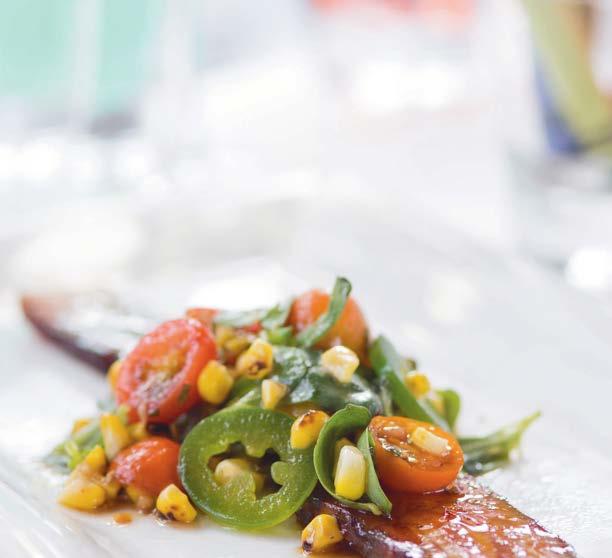











WHATEVER YOU crave, GET IT AT THE CROSSROADS! WITH OVER 50 SHOPS, RESTAURANTS, SERVICES AND SPECIALTIES GET HWY 1 @ RIO RD, CARMEL, CA 93923 831.625.4106 THECROSSROADSCARMEL.COM Remember to wear face coverings and maintain safe distancing. Fresh

THE ORCHARD
OLIVE OIL SYNERGIES
Networking and mentorship make a difference for small producers, from grove adopters to a former governor
BY CHERYL ANGELINA KOEHLER
Kim Null and Jamie de Sieyes rest for a minute as they check the quality of their justharvested olives, which are headed straight to the mill. (Photo courtesy of Wild Poppies)

IN
www.ediblemontereybay.com 43
It’s a cool December day in 2017, not long after Olga Orlova’s Santa Rosa home burned down in the Tubbs Fire. The young Capay Valley olive oil producer is preparing for a long day of milling when her phone rings. A voice on the other end says, “This is the governor of California, Jerry Brown.”
“I thought it’s a joke,” says Orlova.
After a polite “Hello, Governor of California Jerry Brown, how can I help you?” she learns that Brown’s 140 olive trees, recently transplanted to his Mountain House ranch in Colusa County, have ripe olives. Olga Orlova, as he’s been told, is the person who can help him.
To fully appreciate the irony of a powerful national leader calling a young, recent immigrant for advice, let’s jump back a decade as Orlova is enjoying her first career developing recipes for a milk company in her native Russia. She longs to travel, and by 2010, she’s in San Francisco exploring logistics for becoming a mushroom farmer or perhaps a brewer. On an evening in 2013, she’s in Santa Rosa barbecuing for friends and waxing eloquent on how a good grilled steak needs only salt, pepper and olive oil, when someone mentions that olive oil is becoming a big thing in California.
“Like, big thing in California, what do you mean?”
“They make olive oil here, and right now the market has started growing in the U.S.”
“But isn’t it a Mediterranean product?”
“Yeah, everywhere wine grows, olives can grow.”
While the group tucks into their unctuous olive oil-slathered steaks, Orlova further queries her California ag-savvy friends enough to determine that coaxing the delicious oil from this Biblical tree fruit and marketing it might be her true calling. Within two weeks she’s leapt over a chasm of innocence and charmed her way into the orchards and mills of esteemed local olive oil producers, plus labs and offices of sundry top-level researchers, testers and administrators, and is well along in her launch of Olica, a boutique olive oil company.
Fast forward four years, and this budding entrepreneur has racked up awards for her olive oils and simultaneously established a strong reputation for helping other small growers mill their fruit into high-quality oil (or acquire equipment and know-how to mill their own). That’s when the governor calls.
“Honestly, we don’t know what we’re doing here,” she recalls Brown saying.
“I go to his place. We need to harvest now,” says the miller, who knows that oil of superior quality, such as the governor expects, can only be achieved when the olives are at a perfect, subtly pre-ripe moment and are milled immediately upon harvest before any deterioration sets in.
“What time do we start?”
Brown is just heading out to give the President an aerial tour of the fire devastation, but four cheerful, young, casually clad people hanging around Mountain House—who turn out to be the governor’s security contingent—help Orlova harvest the olives. Back at Olica central, she mills the olives and bottles up the oil, affixing the governor’s Mountain House label.
While the miller helps Brown learn about taking the product from tree to table, the two strike up a friendship. And when Orlova learns that he has it in mind to sell the bottles at Whole Foods, she has to break the
sad news that being the governor of California paves no golden-green path toward getting this very limited supply of Mountain House olive oil out to the people of the Golden State via that particular venue.
Given the enduring resilience of this very long-lived, drought-tolerant tree and its long cultural role as a nurturer of humankind, it makes sense that an environmentalist governor might like to steward an olive orchard and pursue olive oil production in retirement. In fact, each person interviewed here was similarly attracted to the tree’s ecological story as well as to the long history of olive oil as a shared community enterprise.
And, of course, there’s always the matter of olive oil’s great taste.
THE DRAMA AND THE MYSTERY
In 2011, Kathryn Tomajan, cofounder and producer of the Oaklandbased Fat Gold olive oil company, was a 20-something graduate student studying food culture and communications at the University of Gastronomic Sciences in Pollenzo, Italy, when she got tricked by a master Tuscan olive oil producer into tasting a rancid olive oil. She thought, “It’s good—it tastes like olive oil,” a misconception all too common among consumers inured to the off flavors of inexpensive, outdated and possibly ersatz supermarket olive oils. Tomajan quickly learned the difference.
“I was really taken aback by the quality and adulteration scandals that are occurring globally in the olive oil trade,” she says. “That really was my hook into olive oil; the drama and mystery around it.”
Influenced in her thesis research by Tom Mueller’s then newly published exposé, Extra Virginity: The Sublime and Scandalous World of Olive Oil, Tomajan also delved into emerging reports from the UC Davis Olive Center by researcher Selina Wang, who as a young and recent immigrant from Taiwan had driven all over California collecting supermarket samples of oils marked extra-virgin for the center’s lab to analyze. The findings? “Reports said that many of our extra-virgin olive oils did not meet the extra-virgin grade standards,” says Wang. From her current seat as the Center’s research director, Wang has now turned her attention to analyzing similar standards that can assist across California’s food landscape in a time of change.
Tomajan’s quest to understand how the fraud problem could be addressed took her to Australia, a major world olive oil producer, which, as she describes, was then “several years ahead of California in establishing mandatory, industry-wide quality standards.” She went back again to apprentice with a small Australian milling operation staffed entirely by women. “I don’t think it’s normal anywhere in the world to have women actually running the mills and doing the difficult work of managing production,” she says.
To school her palate, Tomajan participated in the (now defunct) UC Davis Sensory Panel and then moved on to join the California Olive Oil Council (COOC) Taste Panel, where she continues to participate in its evaluations for producers seeking extra-virgin certification for its oils via rigorous lab and sensory testing. Three videos starring the convivial Tomajan on the COOC website are examples of her fast-developing role as a spokesperson for California olive oil.
In a discussion regarding Tomajan’s role in encouraging her peers, Orlova mentioned the series of personal and professional growth events Tomajan ran with three collaborators from 2011 to 2018 in locations around the country. Called Eat Retreat, the project encouraged participants working
44 edible MONTEREY BAY SPRING 2021
Women olive oil producers clockwise from top left: In the milling room, Kathryn Tomajan constantly puts her olive oil through a series of lab and sensory tests to determine mill settings for the best outcome.
(Photo courtesy of Fat Gold); Olga Orlova checks olive ripeness in her Capay Valley orchard.


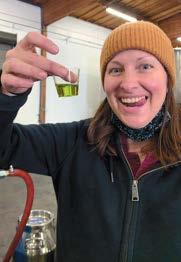

(Photo by Cheryl Angelina Koehler); Susan Ellsworth visits her Flatlands olive trees during the winter harvest season.

(Photo courtesy of Flatlands Oil & Mill); Wild Poppies oil drips like gold in the packing shed.
(Photo by Will Duncan) www.ediblemontereybay.com

45
www.ediblemontereybay.com
45
in many facets of food and agriculture to experience themselves as part of a community dedicated to strengthening the food system as a whole.
Olive oil presents many challenges for a small producer, among them how to afford land for an orchard, how to harvest and mill quickly and cleanly enough to win extra-virgin certification, where to mill if you can’t afford to buy your own equipment, how to market and also how to convince consumers reaching for that cheap commodity supermarket oil that a small local producer’s product is worth the higher $20–$40 price tag. Sharing knowledge and resources is crucial to the endeavor.
SYNERGIES IN ADOPTED ORCHARDS
In 2017, Tomajan was making olive oil alongside one of her Eat Retreat collaborators at Enzo Olive Oil Co. in Fresno when the inspiration to start her own olive oil company came along. A landowner in the Alameda County community of Sunol had a mature olive grove going untended and offered to let Tomajan take over harvesting the fruit in trade for maintaining the orchard. While Fat Gold now sources olives from growers in diverse locations (much the way urban winemakers buy their grapes), during that first year in Sunol, Tomajan started learning firsthand about orchard management, harvesting, milling, packaging and marketing, all of which require a small producer to develop many relationships with others in this labor-intensive business for it to be affordable. (Note: Now in year four, Fat Gold is finally paying small salaries to Tomajan and partner Robin Sloan.)
The notion of adopting a field or an orchard was lionized by veteran organic farmer, writer and olive oil producer Mike Madison in “The
Beginning Farmer’s Plight,” his Fall 2015 article for Edible East Bay. The story outlines how and why a landowning farmer heading toward retirement could (and should) bring young aspiring partners into the enterprise for the sake of imparting knowledge and keeping fertile land in its valuable agricultural usage. Young farmers Susan Ellsworth and Colin Dixon were his test case, and the couple now steward some of Madison’s mature, organically farmed olive trees to make their Flatlands olive oil. They share Madison’s 100% organic facility, including the mill and a certified organic kitchen, where Madison’s wife Dianne makes olive oil cosmetics.
SOWING WILD POPPIES
Chris Banthien (center) helps Jamie de Sieyes and Kim Null learn how to harvest in their newly adopted olive orchard. (Photo courtesy of Wild Poppies)

In a lovely hollow of the Santa Cruz Mountains, sisters-in-law Jamie de Sieyes and Kim Null landed a grove adoption opportunity similar to Tomajan’s along with a mentorship like Ellsworth’s.
In 2016, de Sieyes was tiptoeing from early motherhood back into her marketing career just as her sister-in-law, Null, also a young mother, was developing a passion for agriculture that would later blossom into EatLocal.Farm, a virtual sales model she spearheaded for the local grower community. The sisters-in-law had always wanted to grow a business together when an opportunity appeared as if to fulfill their wishes.
“Just around the corner, a neighbor of ours has a beautiful olive orchard,” says de Sieyes, speaking of Chris Banthien, producer of the award-winning Olio del Le Colline di Santa Cruz, who planted her
46 edible MONTEREY BAY SPRING 2021
grove in 1996. “Having Chris be our mentor, that was the biggest piece of Wild Poppies coming into existence. It enabled us to work together and work near our homes, to work in our community and to have an existing agricultural piece that was well nurtured and well cared for.”
Banthien trained the duo in orchard management and showed them how to harvest using large electric shaking rakes. They learned about milling and bottling by working alongside their miller, Greg Traynor of 43 Ranch in San Ardo, in southern Monterey County. But of equal importance has been the way Wild Poppies was nurtured by the local farmers’ market in Aptos.
“[They] welcomed us as we transitioned from Chris’ brand to ours, and that was a key part of our business thriving that first few months,” says de Sieyes. The sisters-in-law have cultivated deep relationships with their customers, which include local tastemakers like Michelin-star chef David Kinch, who uses Wild Poppies Extra Virgin Olive Oil exclusively at his newest venture, Mentone in Aptos.
In this season when olive harvests have been light throughout most of California, the small supply of Wild Poppies oils has been claimed almost entirely by Null’s EatLocal.Farm customers. “They kept us going this year after the restaurants closed down. My husband built a little mini barn next to the big barn where we can let customers come and pick up their olive oil and pick up their produce.”
FLAVOR IS THE HOOK
If a bottle or can of extra-virgin olive oil from one of these small specialty producers might seem too dear for daily cooking, a cook interested in flavor (as well as health values) might consider what they could be missing.

“Most mid- to large-scale producers are trying to make a consistent, relatively neutraltasting, all-purpose olive oil to appeal to the masses,” says Tomajan. Conversely, her work at Fat Gold, like that of all the producers in this story, is about “honoring the diverse olive varieties planted here in California and milling them in a way that brings out the best of each cultivar.” She’s talking about bringing out maximum flavor, which is more expensive to produce.
What is a cultivar? De Sieyes says the four young Wild Poppies children can pronounce the names of all the cultivars in their orchard…Ascolano, taggiasca, frantoio, Canino, leccino, maurino. The names reveal the cultivars’ Mediterranean origins, and each has been developed over many centuries to highlight distinct flavors. Part of the differing profiles comes from the mix and levels of polyphenols, the organic compounds found abundantly in plants, which, according to a 2018 National Institutes of Health abstract, “have become an emerging field of interest in nutrition in recent decades. A growing body of research indicates that polyphenol consumption may play a vital role in health through the regulation of metabolism, weight, chronic disease, and cell proliferation.”
On the table, an olive oil with high polyphenols is likely to provide a distinctly exciting pungency, which tickles the throat and can even make you cough. Try drinking some “neat,” as credentialed sensory testers do, or just drizzle enough onto a dish to see how a well-made oil adds layers of gorgeous flavor.
Olga Orlova describes her Olica Picual as having a “tomato herbaceousness.” Her Chiquitita offers a “stone fruit nose like apricot and cherry and herbs.” Her Coratina, with its high 460 polyphenol level, gives that robust pungency along with a vivid grassy flavor that stays in the imagination for hours or even years after the meal.
When you purchase extra-virgin olive oil:
• Always check the harvest date, since olive oil is a fresh product that does not keep well for more than a few months, depending on how it’s stored.


• Keep it capped so it doesn’t oxidize.

• Store it away from heat.
• Protect it from light.
• Purchase only oil that’s packaged in an opaque container.

And a most important last piece of advice: Explore the treasures from your local extravirgin olive oil producers to discover all there is to enjoy and support.
Cheryl Angelina Koehler is the editor and publisher of Edible East Bay.
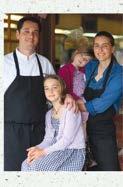
www.ediblemontereybay.com 47 JEROMESMARKET.COM
Our family is so grateful and so honored by all your support these past 5 years!
FOR MORE INFORMATION VISIT
In celebration of our 5th anniversary we are offering to match the first $5000 of donations for the Monterey County Food Bank.
Celery Root and Leek Soup with

Green Garlic Gremolata
Courtesy Cori Goudge-Ayer, chef-partner, Persephone in Aptos
2 tablespoons neutral oil
1medium yellow onion, diced
1medium celery root, peeled and diced into 1-inch pieces
2leeks, washed and chopped into about 1-inch pieces
2sprigs thyme
2bay leaves
Salt and black pepper
5 to 6 cups water
Sweat the onions with the thyme in oil with salt and pepper. Add celery root and cook for a couple of minutes. Add the leeks, water and bay leaves. Bring to a boil, then turn it down and simmer it until the celery root is very tender, about 20–30 minutes.
While the soup is cooking, sauté the green garlic in the neutral oil with a pinch of salt and pepper until tender. Deglaze with the white wine. When the wine has evaporated, transfer green garlic to a bowl and let cool. Once cool, add the zest, parsley, vinegar and olive oil. Taste and adjust seasoning as needed.
Juice of 1 lemon Wild Poppies olive oil
4 tablespoons
For the gremolata
1tablespoon neutral oil
3stalks green garlic, washed and cut into ½-inch pieces
1tablespoon white wine
Zest of 2 lemons
½cup parsley, chopped
1teaspoon sherry vinegar
½cup Wild Poppies olive oil
Salt and black pepper
2 tablespoons of oil. Taste and adjust bowls and top with the
Once the soup is cooked, add the lemon juice. Remove the bay leaves and thyme stems and transfer half the soup to a blender. Blend until very smooth then add olive oil while still blending. Repeat with the remaining soup and the other 2 tablespoons seasoning. To serve, ladle the hot soup into gremolata. Serves 6.
Photo by Chris Schmauch
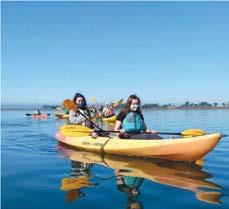

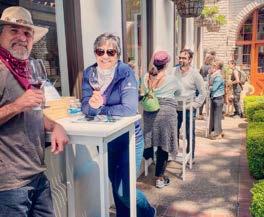



www.ediblemontereybay.com 49 Kirby is
Meet our inspiring faculty. Discover our challenging academic curriculum and individualized instruction. Find out which of our excellent programs is right for your student at one of our upcoming virtual admissions events: our exclusively online academic program or our comprehensive on-campus hybrid program. Now enrolling for the 2021-2022 school year. KIRBY SCHOOL 425 Encinal Street Santa Cruz, CA 95060 KIRBY.ORG (831) 423-0658 admissions@kirby.org EMPOWERING STUDENTS TO SHAPE THEIR FUTURES WITH CONFIDENCE. TASTING ROOM SAN CARLOS & 7TH CARMEL-BY-THE-SEA ESTATE WINERY 1972 HOBSON AVE GREENFIELD FAMILY-OWNED & ESTATE GROWN SINCE 1972 • SCHEIDFAMILYWINES.COM Our Tasting Rooms are Open for Outdoor Experiences. Award Winning Chef Ayoma Wilen Catering for any occasion Call for Take Out Orders (831) 457- 2350 736 Water Street, Midtown Santa Cruz • (831) 457- 2350 Specialty crafted white & red Pearl Wines Fresh, local, organic, Ayurvedic Healing Food
an independent college preparatory school in Santa Cruz for grades 6-12.
ALTITUDE. ADD SOME




Elevate your next wine pairing with LE GRUYÈRE® AOP , made for over 900 years from the purest cow’s milk in the Swiss Alps. Gruyère AOP’s nutty complexity sings with Chardonnay, boosts a Beaujolais, and perfects a Pinot Noir. For more information and some great recipes and pairing ideas, visit us at gruyere.com. Cheeses from Switzerland. www.cheesesfromswitzerland.com

50 edible MONTEREY BAY SPRING 2021 Switzerland. Naturally.



EDIBLE ENTERTAINING LAVENDER CHÈVRE CHEESECAKE

A festive dessert for any springtime occasion RECIPE AND PHOTOGRAPHY
We don’t always think of milk as a seasonal item, commoditized as it is. But milk is often freshest in the spring, when baby animals are first born; the return to lactation after the winter hiatus from milk production is known as “freshening” for good reason. Of course, chèvre or goat cheese is available from the store year-round in most parts. But this cheesecake recipe is perfect for spring in other ways as well, being light and fresh and decadent all at once. With the tang of fresh chèvre, sweetness of sugar and floral bitterness from the lavender, this cheesecake stands up, crustless, adorned with berries, as the perfect harbinger of spring, in dessert form.
BY JESSICA TUNIS
Butter, for springform pan
2 tablespoons dried lavender flowers
12 ounces chèvre or fromage blanc
3 teaspoons lemon zest (from about 3 Meyer lemons)
1½ teaspoons vanilla extract
3 tablespoons all purpose flour
6 eggs, separated
For topping (optional)
2 pints blueberries or mixed berries
2 tablespoons honey
¼ cup water
1 teaspoon dried lavender flowers
Preheat the oven to 350° F. Butter a 9-inch springform pan and dust the inside with white sugar.
Measure 2 tablespoons dried lavender flowers into a mortar and grind with pestle until a fine texture is reached.
In a mixing bowl, combine the chèvre with ground lavender, lemon juice, Meyer lemon zest and vanilla. Add the egg yolks, 2 at a time, and sprinkle in the flour incrementally as you add the yolks. In a separate bowl, beat the egg whites into soft peaks. Softly fold the egg whites into the chèvre mixture and pour into the buttered, sugared springform pan. Bake in the oven for 30–40 minutes, until the edges are set but the center is still a little jiggly.
While the cake bakes, make the topping. Combine 2 tablespoons honey with ¼ cup water and bring to a boil. Add the lavender flowers and remove from heat, allowing the lavender to steep while the cheesecake cooks and cools. Remove pan from the oven and allow it to cool, before running a butter knife around the edges of the pan to release the sides.
Unmold the cheesecake, and chill for at least 1 hour before serving.
To serve, toss the berries with the cooled honey lavender syrup. Lavender flowers in the honey syrup should be soft and sweetly edible, but can be strained out if desired. Scatter the glazed berries over the top and serve immediately. The honeyed syrup helps keep the berries in place. Enjoy! Yields 1 cake.
Jessica Tunis lives in the Santa Cruz Mountains and spends her time tending gardens, telling stories and cultivating adventure and good food in wild places.
www.ediblemontereybay.com 51
EDIBLE ADVENTURE
NORTH STAR
Orcas Island is a pinch yourself kind of place, where waterfalls tumble through temperate rainforests, gas stations offer oysters on ice, windspun art installations hang from old-growth trees and residents set out bunches of lavender along the road requesting poetry in exchange.
A year-round population of 5,000 shares the isle with mountains called Turtleback and Constitution, and a twisting cypress tree that stretches over crystalline Cascade Lake, inviting a climb and a leap. Old heirloom apple trees grow all over. Marine life proliferates, from killer whales to spiny lumpsuckers.
Tucked in the top left pocket of the Pacific Northwest near the border with Canada, the horseshoe-shaped island defies succinct description. One relatively new resident, chef Quinn Thompson, has probably come closest; “Big Sur Island,” he calls it.
It’s also a place that has got better—or at least better tasting—even as 2020 got worse, thanks to the renaissance of the historic Orcas Hotel, which sits on top of the ferry landing that conveys people to and from the Washington mainland and other San Juan Islands.
That evolution is happening with the help of Thompson and the hotel’s new chef-owners Julia Felder and John Cox, an Edible Monterey Bay contributor and partner at Carmel’s Cultura comida y bebida, along with a talented band of apprentices and hospitality lifers including Monterey County restaurant pros, Kyle Odell and Marsella Macias.
They’re cultivating the type of place that feels like it could only exist right there on Orcas. And while it’s very much a specific experience, the way Cox and company are going about things could influence momand-pop lodging around the world.
But don’t take my word for it. I’m biased. I lived, ate and worked with the Orcas team for two months as its first artist-inresidence, writing about the team, hotel and the island, but also painting stairs, washing dishes, expediting plates, stacking firewood, dumping garbage, weeding gardens and flipping hotel rooms, partly because up at Orcas it’s an all-hands-on-deck kinda deal.
 Chef John Cox follows his heart to a haunted hotel on a remote island in the Pacific Northwest STORY AND PHOTOGRAPHY BY MARK C. ANDERSON
Chef John Cox follows his heart to a haunted hotel on a remote island in the Pacific Northwest STORY AND PHOTOGRAPHY BY MARK C. ANDERSON
Take it instead from the most time honored island authority you’ll encounter at Orcas Hotel, and the one with whom I happened to share Room 9: the ghost of Octavia Van Moorhem.
FIXER UPPER
Octavia’s family finished building the hotel in 1904, so creaks and quirks are to be expected. The welcome letter that greets guests acknowledges all that up front—Octavia’s occasional games, old stairs, thin walls and ferry landing traffic—and comes with earplugs. For Cox and Felder, those elements are reasons they wanted the place. As the letter goes on to say, “We love it, but it’s not for everyone.”
The couple was years into a concerted search for a spot to call their own when Cox found Orcas after an hours-long session of habitual scrolling through BizBuySell.com, seeking for-sale-by-owner offerings with history.
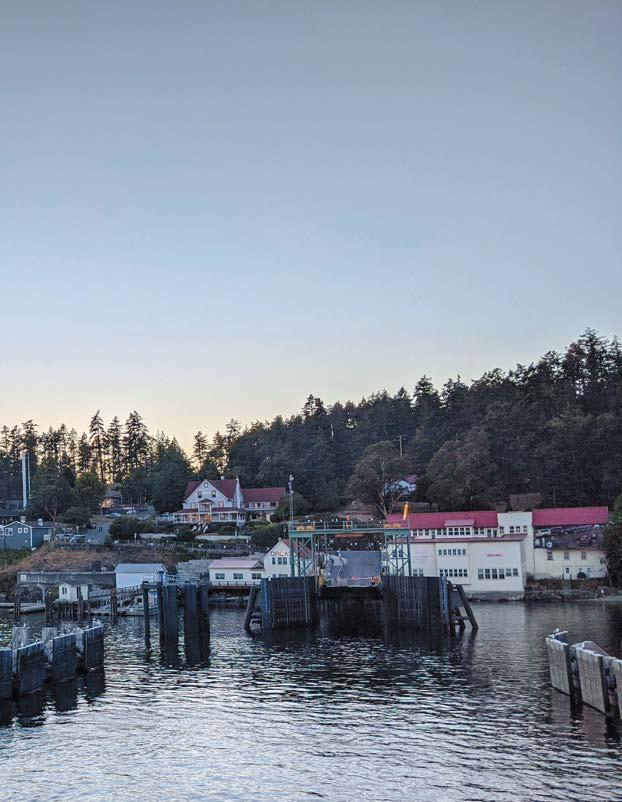
The Orcas Hotel description, he says, “was a terrible listing. It looked like a scam.”
But a call led to a visit that led to verified possibilities, and the craggy terroir of the island resonated for a pair who honeymooned in Scotland (and bid on a bed-and-breakfast in a tiny village called Tarbert). A deal coagulated over six months, and by January 2020 the newlyweds were full-time residents. They started updating the grounds before escrow closed and pounced on café buildout once it did, ripping
out carpet and reinventing the pastry case just as indoor dining was closed with the outbreak of COVID.
Improvements have been a constant since, from new tin ceilings in the still-unopened restaurant to all new appliances in the kitchen. “We figured we’d gradually replace one at a time as they went out,” Cox says. “Then we realized they were all broken.”
The café patio has found new life with a tent, lights and fire pits. Macias planted a chef garden. Just the other day the Orcas team decided they’d had enough with the uneven tile by the dish pit, so innkeeper apprentice Aileen Shea hauled off to the hardware store and a couple of hours later Cox, Thompson and Shea had Skilsawed down to the foundation, laid new cement and particle board, retiled and sealed the new surface all before dinner service.
But the most appealing update is the Chef’s Library. Once home to little more than stained carpet and a pull-down projector screen—“like a church conference room from the ’70s,” Cox says—it now hosts a working fireplace, period furniture, glowing shelves lined with scores of cookbooks and a polished whiskey cabinet filled with finds from around the world.
www.ediblemontereybay.com 53
The most compelling item on those shelves is not Cox’s set of Culinary Chronicles , which maxed out his credit card as a 22-year-old line cook after a late shift at Sierra Mar and a bottle of wine. And it’s not the Octomore 11 single malt whisky by celebrated Scottish producer Bruichladdich, a distillery Cox and Felder liked so much they named their dog after it. (He goes by “Brooks,” and writes his own welcome letter to canine visitors, paired with chef-made dog treats.)
The most telling item is also the earliest entry in Cox’s collection, a book titled So ~ You Want to Be an Innkeeper, a 16th birthday gift from his aunt. She knew how much the family loved staying in bed-and-breakfast inns when they traveled, and that, as Cox puts it, “B & Bs were always on my radar; cooking for people, having a piece of property and creating a sense of place was something I always wanted to be good at.”
That informed his work as he started cheffing young and rose quickly, gathering awards and creative control at stops including Casanova, Hotel Hana-Maui and Post Ranch Inn, where he met Felder, herself a gifted chef. It was his second tour at Sierra Mar that convinced me he ranks among the most thoughtful chefs I’ve encountered, with a knack for narrative—I’ll never forget his Rumsen-inspired menu with acorn bread, rattlesnake and ant-spiced miner’s lettuce—which bodes well for a place with as much identity as Orcas.
“Whether I was working in Hawaii or Big Sur, I always wanted to create something that is that place,” he says. “That’s what’s great about a bed and breakfast. It has a soul and reflects the environment it’s in.”
Along the path he encountered colleagues who entertained similar dreams of ownership—but didn’t know anything about, say, byzantine bookkeeping or small business loans. With Orcas, he and Felder saw a chance to change that. They put out a nationwide request for staff willing to sign up for an 18-month stint, pledging a full-fledged crash course
on how to manage a hotel.
From a field of 500-plus applicants, they handpicked five and trained them on everything from the register to housekeeping to pastry cheffing. At staff meetings, Cox and Felder disclose normally confidential things like balance sheets, business strategy and guest check averages. Each team member has access to below-market staff housing, that includes a yurt, a teepee and a tiny home. They can attend field trips to farms, dinners and distilleries, and have the option of completing a survey that generates a grid of professional and personal development goals. (Grids include everything from learning payroll and how to manage overtime to hunting local wild boar and making prosciutto and smoked sausage from it.)

The approach is both ambitious and practical. It offers training that could be time consuming and cost prohibitive in a culinary school context, while giving the business a flexible workforce where it’s not easy to find one.
“Everyone participates,” Cox says. “We cross-train on everything. People like to say this person can’t do espresso, or can’t serve, or can’t bake great desserts, or is purely a housekeeper. We don’t limit our team to a particular job. We want them to have aspirations for other things. I hate to call it innovative, but no other properties are doing it.”
54 edible MONTEREY BAY SPRING 2021
“B & Bs were always on my radar; cooking for people, having a piece of property and creating a sense of place was something I always wanted to be good at.”
(Clockwise
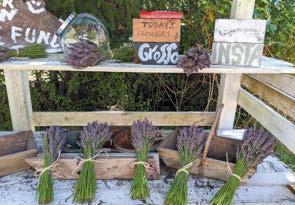
Felder—pregnant with Stanley Norfleet Cox, who was born Sept. 18—on the hotel veranda; apprentice Aileen Shea helps paint the new dining room; locals set out bunches of lavender; Cox installs tin ceilings in what will likely become a destination for intrepid eaters and island regulars alike.


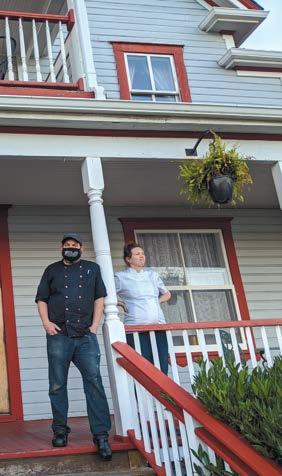
www.ediblemontereybay.com 55
from left) Emily Silks, Kyle Odell, Jessica Naldo, Quinn Thompson, John Cox and Julia
GHOST STORY
You can make a strong case Octavia Van Moorhem and her family gave Orcas Island its most iconic building. Given how hundreds flow through on their way to the ferry every day, and the hotel’s tradition of hosting not just drinks and snacks but also thought salons and societal functions, the hotel gives the island its own combination of Grand Central Station and Café du Monde.
Octavia’s legend, however, isn’t just the building, but her cooking, namely fruit pies, fried chicken and Belgian cookies. She’d ring a bell and those camped on platforms around the dock would come running for $2 dinners that would leave the extended family overfed. Island historian, professional storyteller and ghost expert Antoinette Botsford is one of her fans.
“She was very good-natured and just loved to make people happy,” Botsford says. “She loved to eat.”


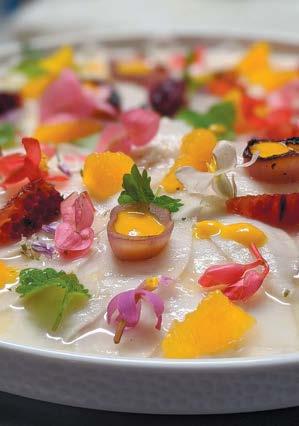
Octavia’s legacy translates in full to the new era. Yes, the hotel does have rooms offering homey accommodation to complement sweeping views of the Salish Sea and surrounding islands, but this is a food operation first and foremost, as salivating Instagram followers can testify. The go-tos—New Mexico-style breakfast burritos, big burgers and beer-battered fish ’n’ chips among them—sell with the consistency of the tides. But the kitchen team comes to play with specials.
“For a long time Orcas Cafe was all about tourism, extracting dollars from people waiting for ferries—coffees and croissants,” Cox says. “We figured tourists are always gonna be here, and if they like it, great, if not, fine. Even pre-pandemic, we wanted to be a locals’ restaurant. So we flipped this hotel on its head and started pushing hard on specials.”
That’s meant Taco Tuesdays and Sushi Saturdays, plant-based boxes and “survival kits” delivered to doorsteps. It’s meant installments of a series called “Grandma’s Kitchen” and savory barbecue pulled from the custom one-ton reverse-flow T-Pit smoker shipped from Ennis, Texas.
56 edible MONTEREY BAY SPRING 2021
Oh—and weeks and weeks of nightly features. One day there’s a French Laundry tribute with salmon tartare cones, roasted duck and black truffle, another there’s New York-style street kebabs. Recent hits include Veracruz-style steamed mussels, smoked shiitake mushroom okonomiyaki pancakes and chicken-fried steaks.
“We take anything and run with it,” Thompson says. “We can do finer and nicer, but we can do the sloppiest Joe you’ve ever seen.”
Odell, whom Monterey Bay eaters will remember from stops at Carmel Belle and Cultura, leads front-of-house ops and a drink program based on batch cocktails and island-sourced wine. Craft creations like brown-butter old fashioneds and bloody Octavias give classics a jolt of character but more than anything maximize efficiency as the rush-hour line snakes out the door.
(Clockwise from top left) Wild foxglove drips early morning moisture in Turtleback Mountain Preserve (though Orcas receives only half as much rain as Seattle); Monterey Abalone Co. stars on a 2020 installment of “Sushi Saturday”; wildly creative and colorful chef’s dinners in The Whiskey Room have been a runaway hit.
Odell, a Monterey native, took a chance on Orcas, packing his belongings and his dog Snow and trekking 1,009 miles north to join the team.
“If I was going to take a leap, I would do it with John, the guy I talked to every time I had to make a career decision,” he says.
“Some will sit there and play it safe. He’s going to go for it, be unafraid to take risks and be smart about building a good team that can push and be creative.”
Thompson and Odell often run point on chef dinners in the library, which bode well for the opening of the restaurant, which has a long vintage bar, a big stone fireplace, fresh carpet and fresher paint. Orcas will continue to be a beacon for hikers, sailors and seekers, but if this team has its way, it will be a magnet for foodies too.
“Ideally I would want a guest who came here, got off the ferry and had a similar experience to if I was going to Europe and happened across a place that was extremely special and customized to a region,” Thompson says. “You walk in and it’s the only place that is like it in the world.”
That’s how Octavia would want it. She has a kindred soul in Thompson, who lives at the hotel and loves local history. He has experienced his own interactions with her—once she teased him by throwing tortillas around the walk-in refrigerator and on another occasion conjured violin music only he could hear—which, according to the local ghost whisperer, is the best way to know Octavia approves.


“She is present when people are happy,” historian Botsford says. “Her spirit is hospitality.”
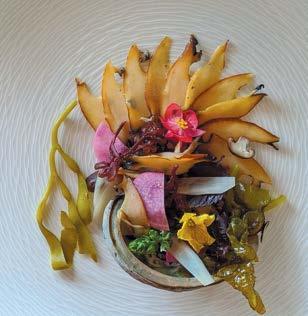

That spirit is alive and well, in a place that feels like no other. Which is pretty much the whole point.
Mark C. Anderson is a roving reporter, editor and photographer based in Seaside, California. Reach him via @MontereyMCA on Instagram and Twitter.

www.ediblemontereybay.com 57 831.476.2263 231 Esplanade, Capitola margaritavillecapitola.com capitola, california BOLD & UNIQUE FLAVORS IN A NEW AGE TAQUERIA SETTING MIJO’S TAQUERIA CAPITOLA VILLAGE • (831) 465.0228











































































58 edible MONTEREY BAY SPRING 2021
ediblecommunities.com Stay up to the minute on all things edible at: ediblecommunities.com edible brooklyn ISSUE T H E Drinks THE STORY OF LOCAL FOOD edible COLUMBUS Complimentary edible manhattan Celebrating the harvest of Marin, Napa and Sonoma counties, season by season MARIN & WINE COUNTRY edible Spring 2020 MEMPHIS edible edible vermont Eat. Drink. Shop. Local
Explore a world of local food through the magazines and websites of Edible Communities. We’ll introduce you to the chefs, farmers, brewers, home cooks and others who inspire and sustain local flavors across the US and Canada.
EDIBLE
D.I.Y.
Pot Primer
Forget the grow lights and fancy fertilizers, a gardening expert explains how to grow your own in 10 easy steps
BY JOHANNA SILVER PHOTOGRAPHY BY RACHEL WEILL
Whether you’re already a fan or just cautiously curious, cannabis, fully legal for recreational cultivation and use in California, is a fantastic plant to include in the garden. Forget what you’ve ever heard about complicated growing practices—that comes from indoor cultivation, where weed has been forced to grow due to a century or so of prohibition. Outdoors, with sunshine and compost, the plant grows quickly and easily, smelling unlike anything you’ve ever included in the garden, making it a most perfect addition to this year’s bounty. There are myriad cultivars to choose from, including CBD-dominant ones that won’t get you high. No matter what, it’s a gorgeous plant in the garden.

www.ediblemontereybay.com 59
Pick a spot
Weed is a quick-growing summer annual. If you’ve got an existing veggie bed, that’s your spot. If not, you want full sun. In gardener speak, that means at least six hours of direct sunlight a day. You also need well-amended soil, and access to water; drip is ideal. A container works fine too. The bigger, the better. Fifteen gallons is great, and drainage is a must.
Procure seeds or a clone
Dispensaries are the only legal spot to score seeds and clones (what gardeners might otherwise call vegetative cuttings). While it might be tempting to grab a clone, consider starting from seed. Seeds are remarkably easy to grow. Start them in smaller cell packs filled with fresh potting soil and plant them ¼-inch deep and keep them watered. They’ll be just fine outdoors. Unlike clones, which are petite versions of older plants, seeds are spritely, young juveniles. They form strong taproots and are most resilient when it comes to any
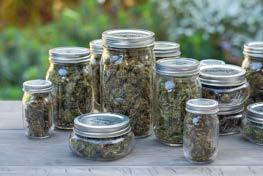

subpar spring conditions. Don’t sweat your selection—choose based on what name or smell you like. All that information about what it will do to you? Entirely subjective.

Get growing
Once the plant is about a foot tall, plant your weed into its eventual home, either bed or container, and watch it grow. Water anytime the soil is dry, down to about half an inch. Some simple trellising—like a tomato cage—will help the plant support its weight as it grows and eventually forms heavy flowers. You’ll want to prune it gently, at least topping it (snipping at the terminal bud) when there are three to five sets of leaves.
2
1
3
60 edible MONTEREY BAY SPRING 2021
Sex the plants
If you’re growing from seed, you’ll need to “sex the plants.” Cannabis has both males and females, and you’re after unpollinated (aka seed-free) flowers as the end goal. While flowering won’t kick off in earnest until after the summer solstice, you can most likely sex them earlier (at, say, two months of age), by getting up close and personal with their pre-flower. You’ll want to look at plant nodes (the spot between the stem and the branch, akin to the armpit). That flap that looks like a flag is called the stipule. Peel that back and you’ll find the sex organ. If you see balls, it’s a male, and if you see a white hair, you’ve got a female. If you’re not sure, give it another few weeks. Male plants should be culled.
Combat pests




Nearly all problems with growing cannabis can be nipped in the bud with proper conditions (plenty of sun, room between plants for airflow, not too much water) at the outset. One persistent problem, however, is bud rot—caused by butterflies laying their eggs in the flowers, hatching into caterpillars that poop inside, eventually forming fungus that you really don’t want to ingest. You can either make peace with losing some of your harvest to this rot (which looks like gray, soft flowers at harvest time), or by giving plants a weekly spraying of Bt (Bacillus thuringiensis), an organic biopesticide that’s toxic to caterpillars and not at all toxic to you. Spray weekly from July through August.
Harvest time
Depending on the cultivar, your flowers are ready to snip sometime in September or October. Flowers are ripe when half the stigmas (those hair-like strands sticking out from the buds) are amber and half are still white. If possible, chop your plants in a way that creates ready-made hooks for easy drying. Instead of cutting branches off from the main trunk or stem, try to include a small section of that trunk to create a V. And don’t worry if your hooks aren’t perfect or don’t happen every time— clothes pins are cheap and do the job, too. Place your harvest on a clean tarp that you can easily transfer to your drying spot.
Dry
Cannabis needs to hang out in a cool, dark spot to dry. A garage or closet will do. Maximize drying space by hanging a line, adding hangers, and suspending branches on hangers, either using their natural nooks or with the assistance of clothes pins. Invest in a cheap hygrometer to ensure that temperatures remain between 60° and 70° F and humidity stays between 50% and 65%. Add a small, oscillating fan to maintain airflow. In 10–14 days, when the branches snap and buds sound like popcorn when pressed, you’re ready to snip the buds off of branches and put them into airtight containers, like Mason jars with locking clasps.
Cure
This final step pulls any remaining moisture out from deep within the bud and creates an even dry. When your bounty first goes into their jars, seal them overnight and check on them the next day. If the flowers seem to have regained their moisture (as measured with a gentle squeeze), leave the lid off all day before resealing at night. Repeat this process, known as burping, until they’re as dry as they were the night before.
Store
Store your cannabis in airtight containers in a cool, dark place—quite similar to drying conditions. Make sure vessels aren’t overpacked and consider adding a two-way humidity pack (Boveda is the brand loved by most) to keep conditions perfect.
Enjoy




Smoked, soaked in alcohol for a tincture, simmered in coconut oil for cooking or given away—your weed is bound to make someone happy.
Johanna Silver’s book, Growing Weed in the Garden: A NoFuss, Seed-to-Stash Guide to Outdoor Cannabis Cultivation (Abrams), was published right when the world shut down. Previously she was the garden editor of Sunset Magazine, where she earned a James Beard Award for her writing. Johanna lives and gardens in Berkeley.

4 5 6 7 8 9 10 www.ediblemontereybay.com 61 MONTEREYBAYFOODTOURS.COM Explore Monterey’s tastiest hidden gems with Monterey’s original walking food tour! DISCOVER. TASTE. ENJOY. 831.204.2211





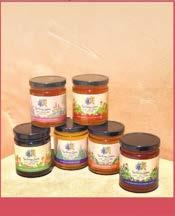

















100% PASTURE-RAISED BERKSHIRE PORK WWW.CALIFORNIAKUROBUTA.COM JOIN THE MEAT CLUB! Our pigs eat kale so you don’t have to! MONTEREY BAY MARKETPLACE 62 edible MONTEREY BAY SPRING 2021 thephilosophersstoneground.com Legendary Nut Butters: Sprouted, Dehydrated, & Stone Ground in small batches. www.offthehookessentials.com instagram: @offthehookessentials essentials, in a pinch!


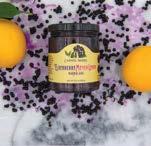



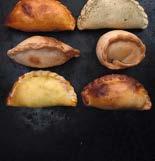




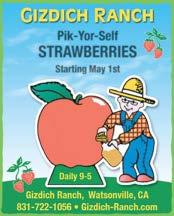




LOCAL PASTURED PORK & EGGS CARMEL VALLEY • CA stenvickfarm@gmail.com | there's a new kid in town Elderberry royaloaksproduce.com 831-204-2116 Local. Organic. Fresh. Right to your door. FREE DELIVERY, NO SUBSCRIPTIONS MONTEREY BAY MARKETPLACE www.ediblemontereybay.com 63
Trendy
CRAFT ROOTS
new spot combines vegan fast food and CBD cocktails
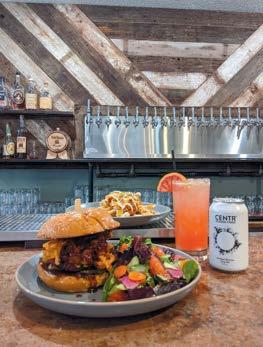 STORY AND PHOTOGRAPHY BY MARK C. ANDERSON
STORY AND PHOTOGRAPHY BY MARK C. ANDERSON
Behold the chili cheese burger with pumpkin-seed chili, queso sauce, crispy hominy and eggplant “bacon.” The sausage-mushroom pizza with sweet peperonata. The chipotle fried trumpet mushroom sandwich, pimento mac ’n’ broccoli and almond butter chocolate chip cookie ice cream sandwiches.
The full-bodied flavors at Morgan Hill’s new Craft Roots Vegan Bar and Grill seize an appetite’s imagination fiercely enough that some newcomers don’t realize they’re eating at a vegan establishment until halfway through a meal.
“People are surprised they can get their dad to eat a vegan burger,” says owner-operator Justin Gaich.
Comfort is its own reward, but there are others, as he points out when asked whether his vegan leanings tip toward compassion for animals, environmental impacts or health concerns.
“All of the above,” he says, “but I don’t get preachy. The restaurant doesn’t have that vibe.”
While Craft Roots may please unsuspecting omnivores, plenty of eaters come precisely because it’s vegan—and not the type of vegan promoting faux meat. “You should have vegetables shine,” is a common refrain heard from Gaich, his wife/co-owner/operator Nyssa and Craft Roots staff. And that philosophy’s on display with items like the seasonal hash bowl, currently styled for winter with chopped lacinato kale, shredded Brussels sprouts, roasted butternut squash, dried cranberries, red onion, spiced walnuts and apple cider vinaigrette.
Roots’ rising dovetails with a wider surge in burger-loving fast vegan throughout the state, many of them similarly unapologetic about their burly takes on it. As places like Malibu’s Burgers, Vegan Mob and Amy’s Drive Thru are flourishing—and expanding—to the north, Los Angeles is a hotbed of strong meat-free storefronts, from Burgerlords to Monty’s Good Burger to Nomoo.
“We don’t want a lot of processed foods,” Nyssa says. “We want to go healthy and really support our farms.” Their favorites include Real Produce, Watsonville Coast Produce and Spade & Plow.
Plant-based plates represent a surprising pivot for the Gaiches after Justin spent years managing neighboring Trail Dust Barbeque.
“Once you get going with vegan, you can sustain your energy without the ups and downs,” he says. “I love the clarity [and] not being burdened by food. It’s hard to describe other than you feel a lot better.”
Still more surprises await: Craft Roots is the rare vegan joint that has a full liquor license. The curated small-production craft beer list is also impressive, with roughly two dozen beers available at any given time, from the likes of Humble Sea, Ommegang and Russian River, the brewers behind wildly popular Pliny the Elder, which Craft releases when it becomes available in famously limited quantities.
With produce also driving the options on the drink menu, recent seasonal concoctions have starred local apples, plums and cucumbers. Nicholas Mattson directs the bar after evolving his game at popular San Jose drink destination Paper Plane—and taste tests each piece of produce he uses to dial in ripeness.
“Balance is the biggest thing for me,” he says. “Too much citrus or too much booze is offsetting. I don’t want our fruits and veggies to get lost.”
Mattson’s most popular cocktail, All the Rage, is a rotating creation based on what’s coming out of the field, splashed with CENTR, a crisp CBD sparkling tonic containing as much as 30 milligrams of stress-relieving cannabinoid.
CENTR fits into a lineup of nonalcoholic kombuchas and other CBD offerings that are selling briskly enough that Craft Roots struggles to keep them stocked.
James Velarde, senior vice president of Coastal Luxury Management, has taken COVID event restrictions as an opportunity to promote CENTR’s burgeoning popularity to restaurants like Craft Roots.
“I really like the direction they’re taking,” he says. “People don’t miss the meat. They’ve caught lightning in a bottle with where we’re going as a society, and they’re doing the same thing with CBD: capturing emerging trends in a fun and creative way.”
64 edible MONTEREY BAY SPRING 2021 LAST CALL
See recipe for Craft Roots’ Stay Centred Cocktail at ediblemontereybay.com



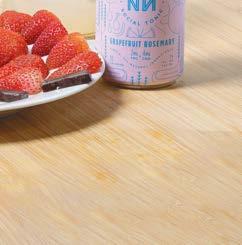




Licenses: C10-0000172-LIC • C10-0000234-LIC View our full menu at kindpeoples.com Find Your Kind Cannabis Edibles for Every Occasion Voted best dispensary in Santa Cruz 533 Ocean St. 8am – 10pm Daily 3600 Soquel Ave. 8am – 10pm Daily Reserve your order online Pick up and pay in store in 30 minutes.
CULTIVATE & FLOURISH


Treat yourself with a visit to our Farm Stand and café. Enjoy the bounty of what is blooming, our fresh produce, curated gifts, and our organic kitchen’s creations. Join us as we welcome Spring and indulge in our ever changing atmosphere.
Follow us on for daily offerings and specials. EARTHBOUND FARM STAND 7250 Carmel Valley Road, Carmel, CA 93923 (831) 625-6219 Earthboundfarm.com


















































































 BY RAÚL NAVA PHOTOGRAPHY BY MICHELLE MAGDALENA
BY RAÚL NAVA PHOTOGRAPHY BY MICHELLE MAGDALENA
























































































 PHOTO
PHOTO








 BY MARK C. ANDERSON PHOTOGRAPHY BY GLEN MCDOWELL AND JOE PLATKO
BY MARK C. ANDERSON PHOTOGRAPHY BY GLEN MCDOWELL AND JOE PLATKO
























 —Amber Turpin
—Amber Turpin



































 Chef John Cox follows his heart to a haunted hotel on a remote island in the Pacific Northwest STORY AND PHOTOGRAPHY BY MARK C. ANDERSON
Chef John Cox follows his heart to a haunted hotel on a remote island in the Pacific Northwest STORY AND PHOTOGRAPHY BY MARK C. ANDERSON




























































































































 STORY AND PHOTOGRAPHY BY MARK C. ANDERSON
STORY AND PHOTOGRAPHY BY MARK C. ANDERSON







